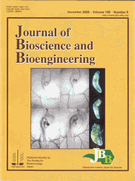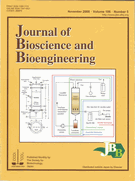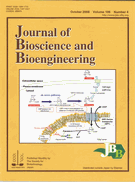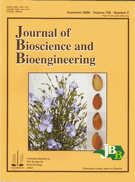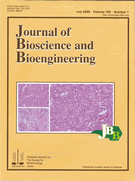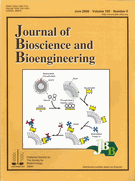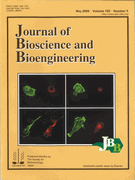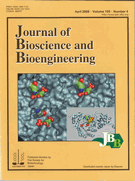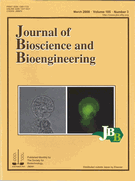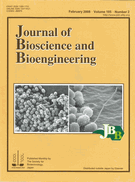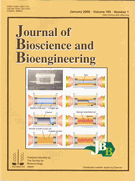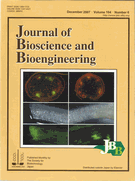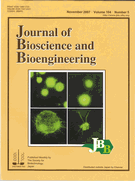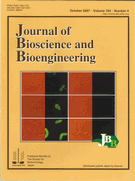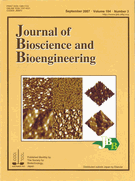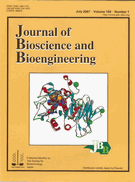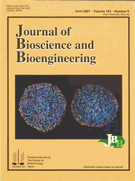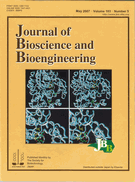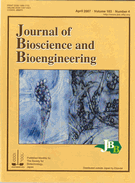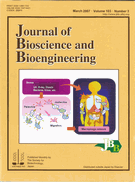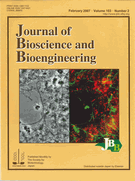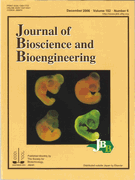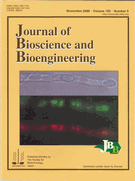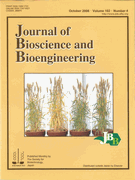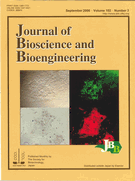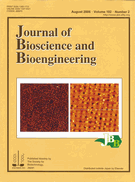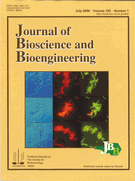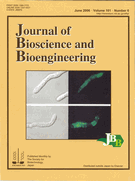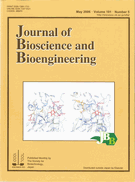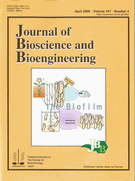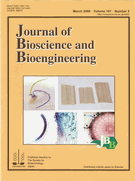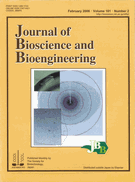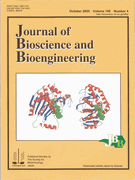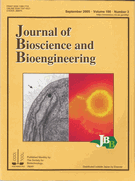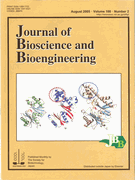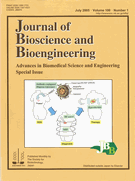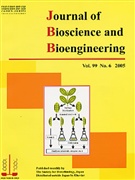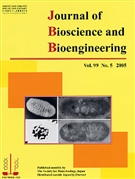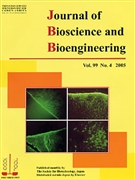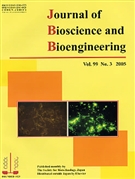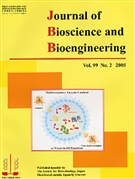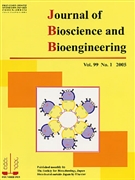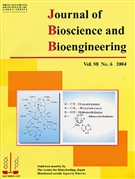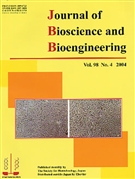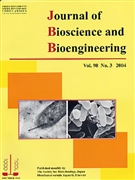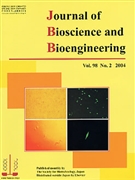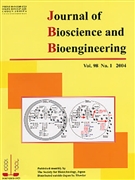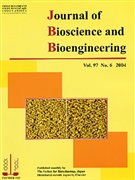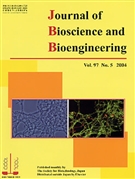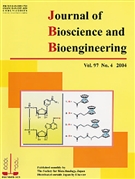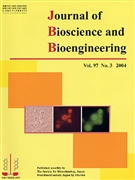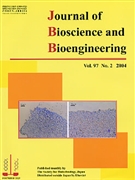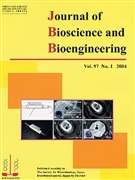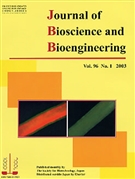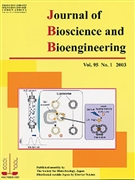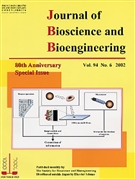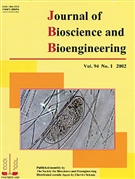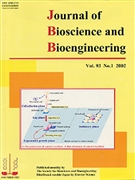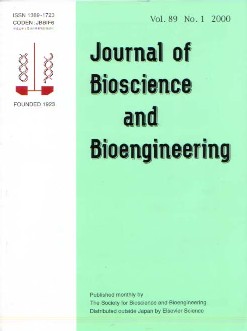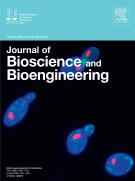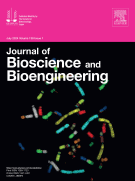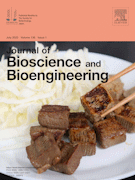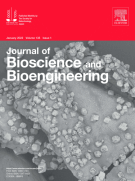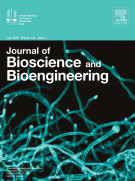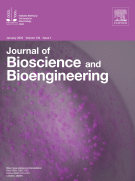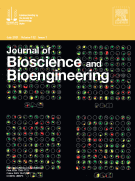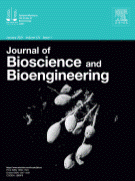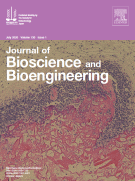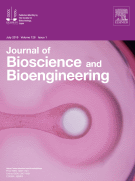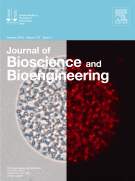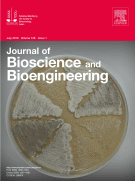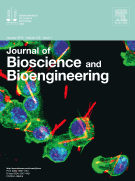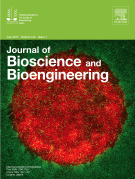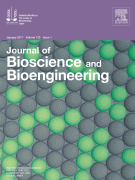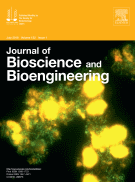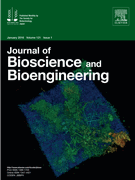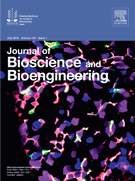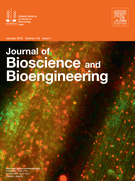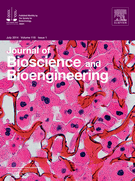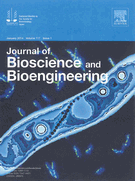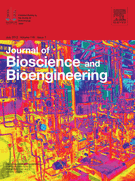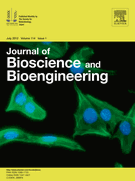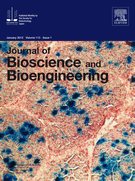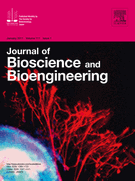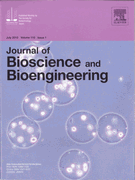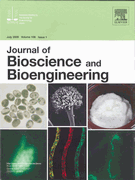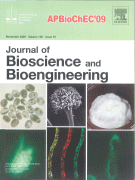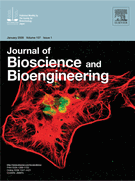Published by 学会事務局 on 02 6月 2025
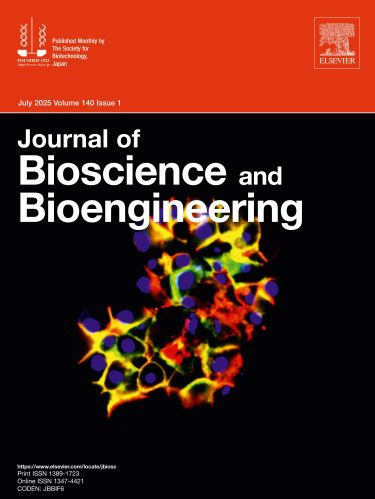
Hepatocytes can be induced to express differentiated functions by forming multicellular spheroids. However, commercially available human iPSC-derived hepatocyte-like cells (HLCs) often lack sufficient intercellular adhesiveness immediately after thawing, making it difficult to form spheroids using conventional methods. We therefore applied a methylcellulose-based technique that utilizes the swelling force of the medium to enable spheroid formation even from weakly adhesive cells. As a result, stable spheroids could be generated from freshly thawed HLCs, leading to marked increases in the expression and metabolic activity of hepatic markers such as CYP3A4, which were otherwise low in two-dimensional cultures. Nevertheless, complete hepatic maturation was not achieved. As shown in this image, the majority of the cells co-expressed both E-cadherin (green) and N-cadherin (red). If a culture method could be developed to recapitulate the complementary expression pattern observed in mature liver—E-cadherin expression in the periportal region and N-cadherin in the pericentral region—the utility of these cells would be significantly enhanced.
For more information regarding this work, read the article: Fumiya Tao, Sanshiro Hanada, Kazuya Matsushima, Hiroshi Arakawa, Naoki Ishida, Yukio Kato, Saya Okimura, Tomohisa Watanabe, Nobuhiko Kojima, “Enhancement and maintenance of hepatic metabolic functions by controlling 3D aggregation of cryopreserved human iPS cell-derived hepatocyte-like cells”, J. Biosci. Bioeng., volume 135, issue 2, pages 134–142 (2023) (Copyright@2025 The Society for Biotechnology, Japan).
⇒JBBアーカイブ:Vol.107 (2009) ~最新号
⇒JBBアーカイブ:Vol. 93(2002)~Vol. 106(2008)
Journal of Bioscience and Bioengineering
Published by 学会事務局 on 17 12月 2024
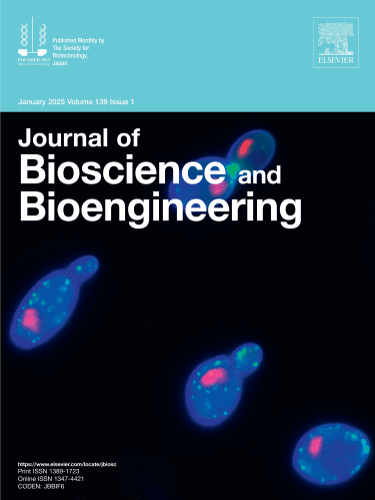
Saccharomyces cerevisiae cell morphology exhibits distinct phenotypes under various culture conditions, allowing for the acquisition of valuable information through its observation. Itto-Nakama et al. established an AI model to predict ethanol production, the primary fermentation product, by monitoring yeast cell morphology under high-glucose stress conditions during fermentation. This method is expected to contribute to enhancing the efficiency of production management and monitoring of desired biocommodities. The image shows a three-colored yeast strain with the nucleus stained with mRuby (pKN4-HTA2 3 x mRuby), actin stained with mNeonGreen (pKN23-Lifeact mNG), and the cell wall stained with concanavalin A CF350.
This image was taken by Chenwei Wang in Ohya Laboratory at the University of Tokyo. The corresponding study has been selected as one of the winners of the Excellent Paper Award 2024 by the Society for Biotechnology, Japan: Kaori Itto-Nakama, Shun Watanabe, Shinsuke Ohnuki, Naoko Kondo, Ryota Kikuchi, Toru Nakamura, Wataru Ogasawara, Ken Kasahara, Yoshikazu Ohya, “Prediction of ethanol fermentation under stressed conditions using yeast morphological data”, J. Biosci. Bioeng., volume 135, issue 3, pages 210–216 (2023) (Copyright@2025 The Society for Biotechnology, Japan).
⇒JBBアーカイブ:Vol.107 (2009) ~最新号
⇒JBBアーカイブ:Vol. 93(2002)~Vol. 106(2008)
Journal of Bioscience and Bioengineering
Published by 学会事務局 on 08 6月 2024
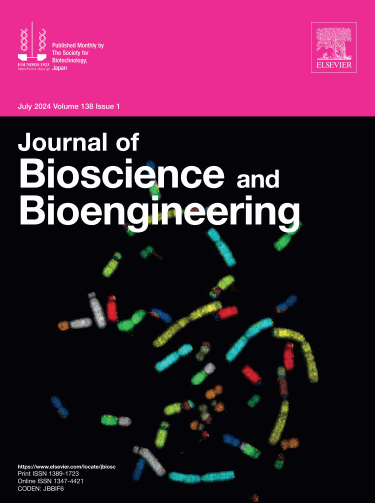
Chinese hamster ovary (CHO) cells are currently the most widely used host cells in the production of biopharmaceuticals such as antibody
drugs, and it is known that the karyotype of CHO cells can be easily changed. The effect of the karyotype changeability of CHO cells on the production of recombinant proteins is an interesting subject. The photograph shows the results of karyotyping of CHO cells with increased chromosome number using the multicolor FISH method, with each chromosome number indicated by a different pseudocolor.
For more information regarding this work, read the article: Noriko Yamano-Adachi, Hirofumi Hata, Yuto Nakanishi, Takeshi Omasa, “Effects of genome instability of parental CHO cell clones on chromosome number distribution and recombinant protein production in parent-derived subclones”, J. Biosci. Bioeng., volume 137, issue 1, pages 54–63 (2024) (Copyright@2024 The Society for Biotechnology, Japan).
⇒JBBアーカイブ:Vol.107 (2009) ~最新号
⇒JBBアーカイブ:Vol. 93(2002)~Vol. 106(2008)
Journal of Bioscience and Bioengineering
Published by 学会事務局 on 19 12月 2023
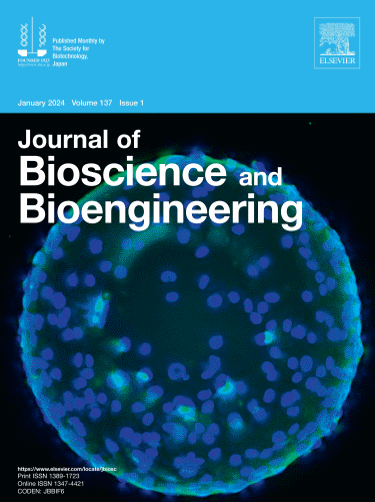
Microcarriers provide a high surface-to-volume ratio that is advantageous for efficient expansion of anchorage-dependent mammalian cells. The authors developed collagen-coated poly(vinyl alcohol) (PVA) microcarriers for the expansion cultivation. The photograph shows cells (blue) expanded on collagen (green)-coated PVA microcarriers.
For more information regarding this work, read the article: Masahiro Kaneko, Airi Sato, Satoru Ayano, Akio Fujita, Goro Kobayashi, Akira Ito, “Expansion of human mesenchymal stem cells on poly(vinyl alcohol) microcarriers”, J. Biosci. Bioeng., volume 136, issue 5, pages 407–414 (2023) (Copyright@2024 The Society for Biotechnology, Japan).
⇒JBBアーカイブ:Vol.107 (2009) ~最新号
⇒JBBアーカイブ:Vol. 93(2002)~Vol. 106(2008)
Journal of Bioscience and Bioengineering
Published by 学会事務局 on 20 6月 2023
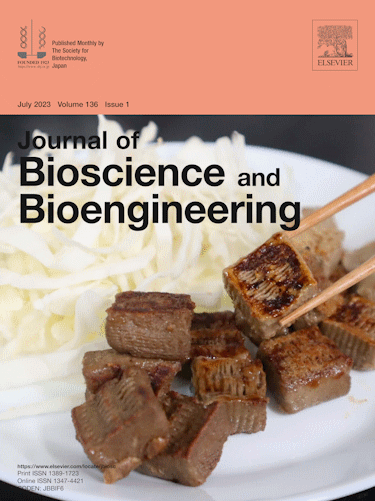
The development of a sustainable source of protein and nutrients is one of the important challenges to achieving a better and more sustainable future for all. For being widely accepted as the source of protein and nutrients in sustainable foods, the technologies enabling to tune shape and texture of the ‘food’ as preferred is believed to play a crucial role. Hiromasa Ohara and Shinji Sakai are developing a technology based on bioprinting technologies for the fabrication of 3D functional tissues and using various sustainable sources of protein and nutrients as inks at Osaka University for contributing to Sustainable Development Goals (SDGs). This image shows a grilled 3D-printed cubic ‘steak’ obtained from an ink containing yeast, Saccharomyces cerevisiae, with a visible fabric structure that mimics muscle fibers.
This image was taken by Hiromasa Ohara in Biochemical Materials Engineering Group, Division of Chemical Engineering, Graduate School of Engineering Science, Osaka University (http://www.cheng.es.osaka-u.ac.jp/sakailabo/home.html) (Copyright@2023 The Society for Biotechnology, Japan).
⇒JBBアーカイブ:Vol.107 (2009) ~最新号
⇒JBBアーカイブ:Vol. 93(2002)~Vol. 106(2008)
Journal of Bioscience and Bioengineering
Published by 学会事務局 on 10 1月 2023
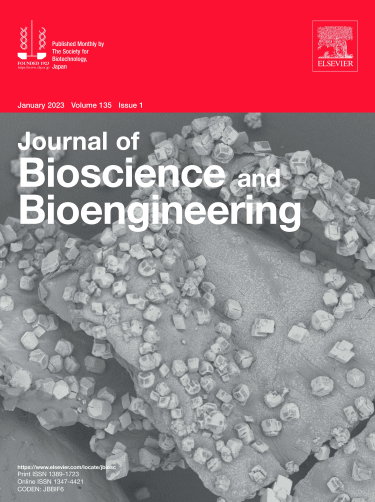
Urease-producing bacteria Pararhodobacter sp. hydrolyzes urea to bicarbonate and ammonium ions, leading to the formation of CaCO3 (calcite, rhombohedral crystal) in the presence of calcium ion. Formed CaCO3 can bind sand particles in water, which can be used for biocementation technique.
This image was taken by Hiranya Nawarathna in Nakashima group, Division of Sustainable Resources Engineering, Hokkaido University (https://bre.eng.hokudai.ac.jp/en/) (Copyright@2023 The Society for Biotechnology, Japan).
⇒JBBアーカイブ:Vol.107 (2009) ~最新号
⇒JBBアーカイブ:Vol. 93(2002)~Vol. 106(2008)
Journal of Bioscience and Bioengineering
Published by 学会事務局 on 15 6月 2022
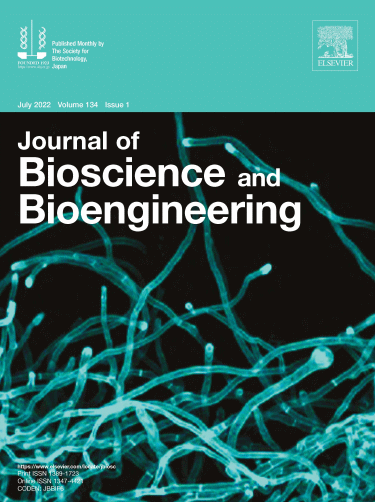
The white koji fungus, Aspergillus luchuensis mut. kawachii, is an industrially important microorganism used in the production of shochu, a traditional distilled alcoholic beverage indigenous to Japan. It secretes large amounts of citric acid that can prevent the growth of contaminating microbes during the fermentation process. The citrate exporter CexA plays a key role in the overproduction of citric acid. The photograph shows the vegetative hyphae of A. luchuensis mut. kawachii.
For more information regarding this work, read the article: Eri Nakamura, Chihiro Kadooka, Kayu Okutsu, Yumiko Yoshizaki, Kazunori Takamine, Masatoshi Goto, Hisanori Tamaki, Taiki Futagami, “Citrate exporter enhances both extracellular and intracellular citric acid accumulation in the koji fungi Aspergillus luchuensis mut. kawachii and Aspergillus oryzae”, J. Biosci. Bioeng., volume 131, issue 1, pages 68–76 (2021) (Copyright@2022 The Society for Biotechnology, Japan).
⇒JBBアーカイブ:Vol.107 (2009) ~最新号
⇒JBBアーカイブ:Vol. 93(2002)~Vol. 106(2008)
Journal of Bioscience and Bioengineering
Published by 学会事務局 on 15 4月 2022
2025 (Vols. 139 & 140) / 2024 (Vol. 137 & 138) / 2023 (Vol. 135 & 136)
2022 (Vol. 133 & 134, 創立100周年特集号) / 2021 (Vols. 131 & 132) / 2020 (Vols. 129 & 130)
2019 (Vols. 127 & 128) / 2018 (Vols. 125 & 126) 2017 (Vols. 123 & 124) / 2016 (Vols. 121 & 122)
2015 (Vols. 119 & 120) / 2014 (Vols. 117 & 118) 2013 (Vols. 115 & 116) / 2012 (Vols. 113 & 114)
2011 (Vols. 111 & 112) /2010 (Vols. 109 & 110) / 2009 (Vols. 107 & 108、特集号<APBioChEC’09 講演要旨集>)
⇒Vol. 87(1999)~Vol. 106(2008)はこちら
►Page Top
Journal of Bioscience and Bioengineering
Published by 学会事務局 on 14 1月 2022
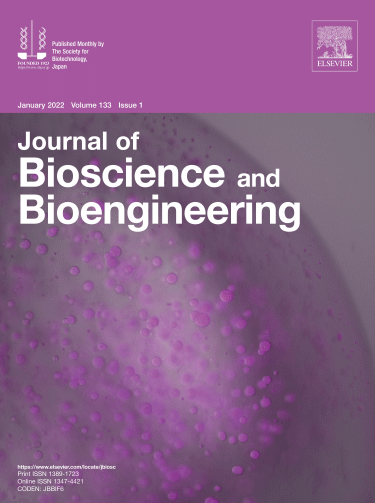
Liquid marbles (LMs) have recently shown a great promise as microbioreactors to construct self-supported aqueous compartments for chemical and biological reactions. To expand the potential of LMs as a three-dimensional cell culture platform, they are transformed to redox-responsive hydrogel marbles (HMs). The photograph shows the cellular spheroids formed by culturing human hepatocellular carcinoma cells (HepG2) in HMs.
For more information regarding this work, read the article: Wahyu Ramadhan, Yuki Ohama, Kosuke Minamihata, Kousuke Moriyama, Rie Wakabayashi, Masahiro Goto, Noriho Kamiya, “Redox-responsive functionalized hydrogel marble for the generation of cellular spheroids”, J. Biosci. Bioeng., volume 130, issue 4, pages 416–423 (2020) (Copyright@2022 The Society for Biotechnology, Japan).
⇒JBBアーカイブ:Vol.107 (2009) ~最新号
⇒JBBアーカイブ:Vol. 93(2002)~Vol. 106(2008)
Journal of Bioscience and Bioengineering
Published by 学会事務局 on 21 6月 2021
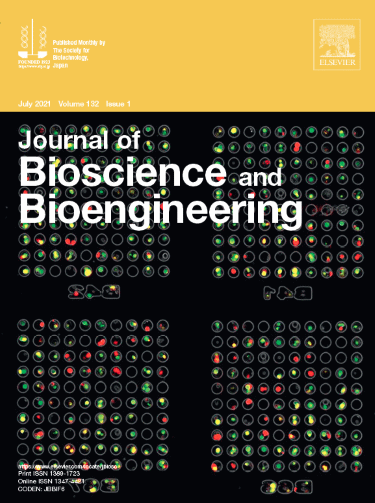
Phagocytosis of apoptotic cancer cells with dendritic cells is an important event for cancer immunology and immunotherapy. So far, phagocytosis has been investigated by flow cytometric analysis of the mixture of fluorescence-stained cancer and dendritic cells. However, there is limited information that can be obtained by quantifying fluorescence intensity. Satoshi Yamaguchi and Akimitsu Okamoto in The University of Tokyo made a single-cell array of the phagocytosis mixture including red-stained dendritic cells, green-stained apoptotic cancer cells and cancer-phagocytizing dendritic cells. This image shows a part of the array and gives information about the ratio of cell pairs in various phagocytic states such as phagocytosis-starting pairs, partially phagocytizing ones and fully phagocytizing ones. This method allows for accurate evaluation of phagocytosis efficiency and reliable isolation of vaccinated dendritic cells.
This image was taken by Satoshi Yamaguchi in Okamoto group, Research Center for Advanced Science and Technology, The University of Tokyo (http://park.itc.u-tokyo.ac.jp/okamoto/) (Copyright@2021 The Society for Biotechnology, Japan).
⇒JBBアーカイブ:Vol.107 (2009) ~最新号
⇒JBBアーカイブ:Vol. 93(2002)~Vol. 106(2008)
Journal of Bioscience and Bioengineering
Published by 学会事務局 on 25 12月 2020
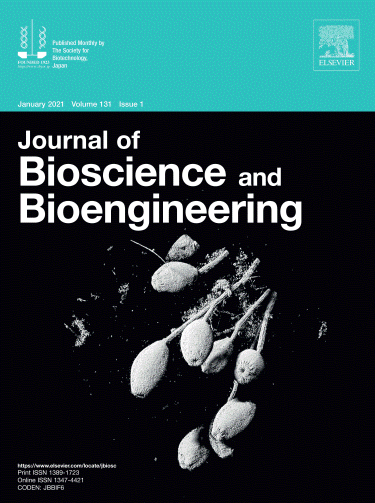
Eukaryotes are an important component of activated sludge and responsible for biological wastewater treatment. The treatment performance depends on the spatial distribution and resulting activity of the sludge microorganisms. However, the mechanism underlying the microbial assemblage formation is still unclear. Tomohiro Inaba and Tomoyuki Hori in the National Institute of Advanced Industrial Science and Technology (AIST) investigate the structure and function of microbial assemblage by confocal reflection microscopy and molecular ecological tools. This image shows a three-dimensional, high-resolution structure of an activated sludge portion composed mainly of ciliate-like eukaryotes. This non-destructive visualization contributes to a better understanding of sociomicrobiology in natural and engineered environments.
This image was taken by Tomohiro Inaba in Environmental Ecophysiological Research Group, Environmental Management Research Institute, AIST (https://unit.aist.go.jp/env-mri/121env-eco/ja/index.html) (Copyright@2021 The Society for Biotechnology, Japan).
⇒JBBアーカイブ:Vol.107 (2009) ~最新号
⇒JBBアーカイブ:Vol. 93(2002)~Vol. 106(2008)
Journal of Bioscience and Bioengineering
Published by 学会事務局 on 11 6月 2020
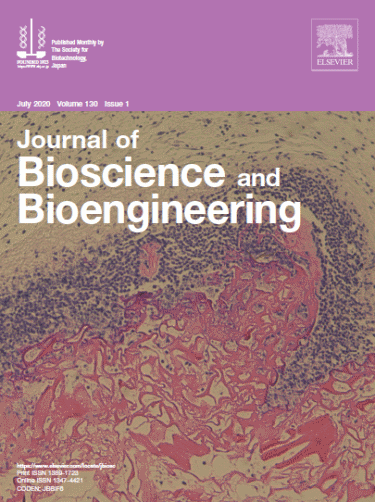
Physically-crosslinked chitosan cryogel was prepared by freeze-thawing of a chitosan-gluconic acid conjugate aqueous solution and sterilized by autoclaving. The autoclaved cryogel retained favorable biological properties of the pre-autoclaved cryogel. The photograph shows hematoxylin and eosin -stained cross-sections of the cryogel (red) implanted into mice and the surrounding tissues.
For more information regarding this work, read the article: Takayuki Takei, So
Danjo, Shogo Sakoguchi, Sadao Tanaka, Takuma Yoshinaga, Hiroto Nishimata, and Masahiro Yoshida, “Autoclavable physically-crosslinked chitosan cryogel as a wound dressing“, J. Biosci. Bioeng., volume 125, issue 4, pages 490–495 (2018) (Copyright@2020 The Society for Biotechnology, Japan).
⇒JBBアーカイブ:Vol.107 (2009) ~最新号
⇒JBBアーカイブ:Vol. 93(2002)~Vol. 106(2008)
Journal of Bioscience and Bioengineering
Published by 学会事務局 on 25 12月 2019
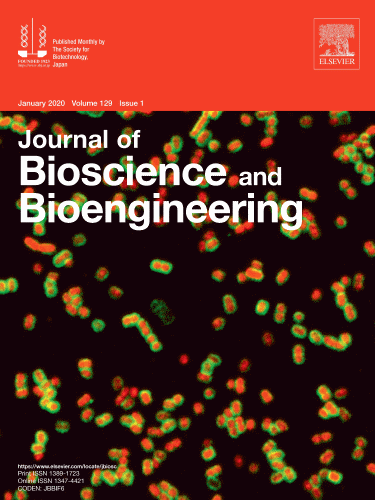
Acinetobacter sp. Tol 5 is a hydrocarbon-degrading bacterium and exhibits noteworthily high adhesiveness to various abiotic surfaces from hydrophobic plastics to hydrophilic glass and metals. This unique nonspecific adhesiveness is mediated by AtaA, a nanofiber protein on the cell surface. The photograph shows a fluorescent microscopic observation of mCherry-expressing Tol 5 cells stained with an anti-AtaA antibody. The cell body of Tol 5 (red) wascovered with surrounding AtaA fibers (green).
For more information regarding this work, read the article: Aoki, S. et al., “Native display of a huge homotrimeric protein fiber on the cell surface after precise domain deletion“, J. Biosci. Bioeng., volume 129, issue 4, Pages 412-417 (2020)(Copyright@2020 The Society for Biotechnology, Japan).
⇒JBBアーカイブ:Vol.107 (2009) ~最新号
⇒JBBアーカイブ:Vol. 93(2002)~Vol. 106(2008)
Journal of Bioscience and Bioengineering
Published by 学会事務局 on 10 6月 2019
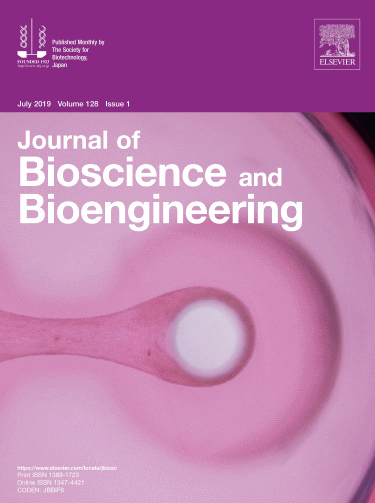
Fabrication of in vitro functional tissues which can accurately model disease condition is required for efficient drug development. Although there are a lot of skeletal muscle related diseases, very few drugs for them have been developed so far. Kazunori Shimizu and Hiroyuki Honda have developed 96 well formatted microdevices for fabricating tissue-engineered human contractile skeletal muscle and applied them to model disease condition such as skeletal muscle atrophy. A ribbon-shaped skeletal muscle tissue with a lot of myotubes is formed between two micro-posts. When the tissue generates a contractile force by electric stimulus, the tip of the post (white circle) moves and the contractile force can be quantified by its displacement.
This image was taken by Nao Yamaoka and Saki Ohsumi at Honda’s laboratory in Nagoya University (http://www.nubio.nagoya-u.ac.jp/proc/index_english.html).
(© 2019 The Society for Biotechnology, Japan).
⇒JBBアーカイブ:Vol.107 (2009) ~最新号
⇒JBBアーカイブ:Vol. 93(2002)~Vol. 106(2008)
Journal of Bioscience and Bioengineering
Published by 学会事務局 on 18 12月 2018
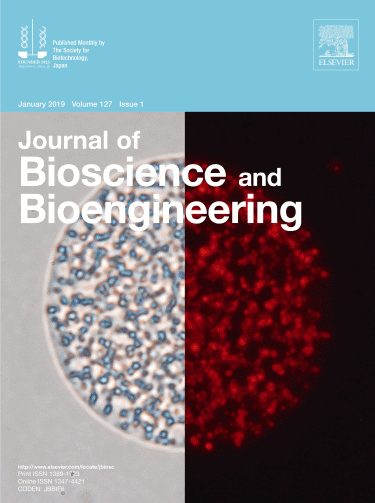
Aurantiochytrium sp. overproducing unsaturated fatty acids (PUFAs) such as docosahexaenoic acid (DHA) and eicosapentaenoic acid (EPA), and carotenoids such as �-carotene and xanthophylls (red droplets). To use the macroalgae Laminaria japonica (Konbu) as feedstock for the bioproduction of value-added lipids, mannitol, the main component of Konbu, should be converted to fructose which can be assimilated by Aurantiochytrium sp.
Following paper has demonstrated the efficient conversion of mannitol derived from Konbu to fructose by the psychrophile-based simple biocatalyst: Tajima, T. et al., “Efficient conversion of mannitol derived from brown seaweed to fructose for fermentation with a thraustochytrid”, J. Biosci. Bioeng., volume 125, issue 2, pages 180-184 (2018).
⇒JBBアーカイブ:Vol.107 (2009) ~最新号
⇒JBBアーカイブ:Vol. 93(2002)~Vol. 106(2008)
Journal of Bioscience and Bioengineering
Published by 学会事務局 on 15 6月 2018
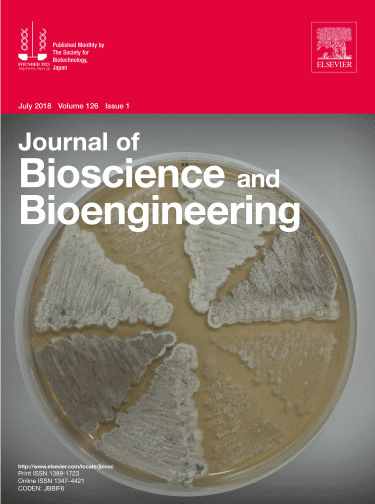
Streptomyces species are gram-positive filamentous soil bacteria that produce a wide variety of secondary metabolites including antibiotics. Genome sequencing projects of many Streptomyces species have revealed that they have a greater genetic potential to produce over 20 secondary metabolites. However, most of secondary metabolite biosynthetic gene clusters are poorly or not expressed under laboratory growth conditions. Kenji Arakawa’s research group focuses on unique biosynthetic machinery of secondary metabolites, their structural redesign, and genome mining for activating silent secondary metabolite biosynthetic genes. The photograph shows various mutants of Streptomyces rochei grown on yeast extract/malt extract/glucose agar medium for 7 days.
This image was contributed by Aiko Teshima at Arakawa’s laboratory, Hiroshima University (http://home.hiroshima-u.ac.jp/mbiotech/5lab/Arakawa/intro-J.html).
⇒JBBアーカイブ:Vol.107 (2009) ~最新号
⇒JBBアーカイブ:Vol. 93(2002)~Vol. 106(2008)
Journal of Bioscience and Bioengineering
Published by 学会事務局 on 22 12月 2017
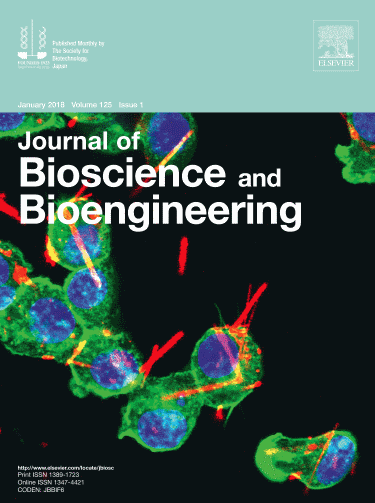
Asbestos is the general term for a number of silicate mineral fibers that have been widely used in construction materials. While most developed countries have banned the use of asbestos, residual contamination remains a widespread problem, with airborne asbestos fibers contributing to the increasing incidence of lung cancer and mesothelioma. The mechanisms of translocation of asbestos and disease development are still unclear. Akio Kuroda’s research group has developed a fluorescent probe (red) for asbestos using an asbestos-binding protein and succeeded in visualization of frustrated phagocytosis of asbestos that has been stated as an important factor in the initiation of an inflammatory response after fiber exposure.
This image was taken by Takenori Ishida and Nobutoshi Fujihara at Kuroda’s laboratory, Hiroshima University (http://home.hiroshima-u.ac.jp/akbio/pg276.html).
⇒JBBアーカイブ:Vol.107 (2009) ~最新号
⇒JBBアーカイブ:Vol. 93(2002)~Vol. 106(2008)
Journal of Bioscience and Bioengineering
Published by 学会事務局 on 26 6月 2017
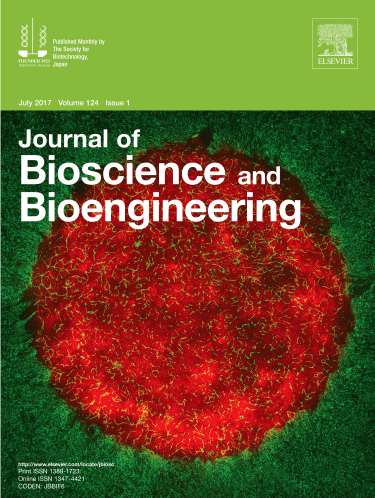
Five-layered tumor-containing cell sheet was prepared by mixing a small population of embryonal rhabdomyosarcoma cells with their healthy counterpart, human skeletal muscle myoblasts and the behavior of endothelial cells in tumor-containing cell sheet was investigated. The photograph shows the degradation of endothelial network formation (green) in the tumor-containing cell sheet (red) at the end of culture.
For more information regarding this work, read the article: Menglu Li and Masahiro Kino-oka, “Degradation of endothelial network in disordered tumor-containing cell sheet, J. Biosci. Bioeng., volume 123, issue 6, pages 748–753 (2017).
⇒JBBアーカイブ:Vol.107 (2009) ~最新号
⇒JBBアーカイブ:Vol. 93(2002)~Vol. 106(2008)
Journal of Bioscience and Bioengineering
Published by 学会事務局 on 26 12月 2016
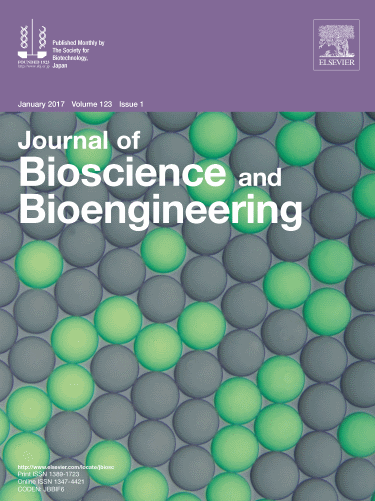
Microfluidic device enables high-speed generation of monodispersed water-in-oil droplets. These picoliter-sized droplets can work as inde-pendent and uniform environments for single-molecule and single-cell reactions. Droplets are compatible with many kinds of chemicals or biological materials, so a variety of biochemical reactions can be performed inside droplets. For example, fragmented single-cell genomes were encapsulated in the droplets and then uniformly amplified with DNA polymerase. The amplicons obtained from droplets (green) can provide uniform and wide genome sequence coverages from single bacterial cells.
The image was taken by Yohei Nishikawa and Dr. Masahito Hosokawa at Prof. Haruko Takeyama laboratory, Waseda University (http://www.f.waseda.jp/haruko-takeyama/).
⇒JBBアーカイブ:Vol.107 (2009) ~最新号
⇒JBBアーカイブ:Vol. 93(2002)~Vol. 106(2008)
Journal of Bioscience and Bioengineering
Published by 学会事務局 on 16 5月 2016
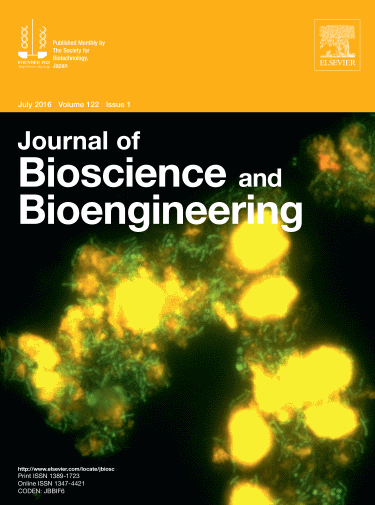
Bacillus subtilis KBKU21 shows two functions in food waste recycling system: production of optically active l-lactic acid as a monomer chemicals for bio-plastic, and plant growth promoting activity in the anaerobically-fermented compost from food waste. The photograph shows selective staining of the bacteria in the compost, observing with FITC-derivative of order Bacillales-specific 16S rRNA oligonucleotide probe, BACILI02. With improved staining and capturing conditions (re-valance of RGB color), thick colonization of Bacillales cells around food waste residue can be clearly observed.
For more information regarding this work, read the article: Kitpreechavanich, V. et al., “Simultaneous production of l-lactic acid with high optical activity and a soil amendment with food waste that demonstrates plant growth promoting activity”, J. Biosci. Bioeng., volume 122, issue 1, pages 105–110 (2016).
⇒JBBアーカイブ:Vol.107 (2009) ~最新号
⇒JBBアーカイブ:Vol. 93(2002)~Vol. 106(2008)
Journal of Bioscience and Bioengineering
Published by 学会事務局 on 18 12月 2015

3D image of the hydroxyapatite (HA) disk and mixed-species oral biofilm visualized by continuous-optimizing confocal reflection microscopy (COCRM). Oral biofilm was produced by mixed-species oral bacteria cultured in TSB medium (1% saliva) on an HA disk. The reflection microscopy-based method COCRM uses reflected light, instead of fluorescence in confocal laser scanning microscopy, as a signal. Thus, COCRM does not depend on fluorescence and permits three-dimensional visualization of biofilms without genetic transformation or fluorescent probing. The COCRM technique can sequentially visualize intact biofilms and reveal their basal materials (in this case, on HA disks). Furthermore, a combination of COCRM and fluorescent proteins or staining can be used to visualize the localization of the subpopulation in the biofilm.
The image was taken by Dr. Tomohiro Inaba at Prof. Nobuhiko Nomura laboratory, Faculty of Life and Environmental Sciences, University of Tsukuba (http://www.envr.tsukuba.ac.jp/~microbio/).
⇒JBBアーカイブ:Vol.107 (2009) ~最新号
⇒JBBアーカイブ:Vol. 93(2002)~Vol. 106(2008)
Journal of Bioscience and Bioengineering
Published by 学会事務局 on 01 6月 2015
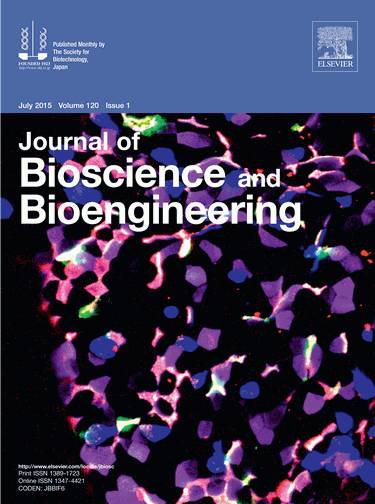
Magnified merged CLSM images of Peyer’s patch sections stained with anti-dengue, anti-M cell complement receptor antibody (C5aR, red),
M cell-specific antibody (NKM 16-2-4), and WGA. There were well-defined patches of overlap between sections stained with anti-dengue antibody (green), M-cell specific lectin (red), and anti-M cell antibody (purple) in the merged image, which indicate that the Tet-EDIII-Co1 protein bound to M-cells, particularly to the C5aR receptor, on the M cell surface.
For more information regarding this work, read the article: Nguyen, N.-L. et al., “Expression and characterization of an M cell-specific ligand-fused dengue virus tetravalent epitope using Saccharomyces cerevisiae“, J. Biosci. Bioeng., volume 119, issue 1, pages 19–27 (2015).
⇒JBBアーカイブ:Vol.107 (2009) ~最新号
⇒JBBアーカイブ:Vol. 93(2002)~Vol. 106(2008)
Journal of Bioscience and Bioengineering
Published by 学会事務局 on 25 12月 2014
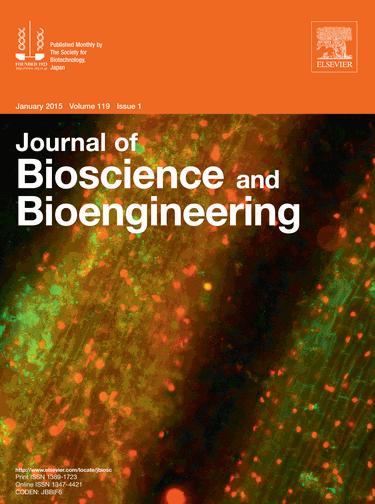
Acinetobacter calcoaceticus P23 is a plant growth-promoting bacterium that was isolated from the surface of duckweed (Lemna aoukikusa) in the Hokkaido University Botanical Garden. The bacterium was observed to colonize on the plant surfaces and increase the chlorophyll content of not only the monocotyledon Lemna minor but also the dicotyledon Lactuca sativa in a hydroponic culture. The picture shows a fluorescent microscopic observation of the roots of L. sativa inoculated with strain P23. The green clusters on the root surfaces show the colonies of the bacterium. The red spots are chloroplasts showing the auto fluorescence of chlorophylls. The amount of chloroplasts in the root cells of L. sativa increased after colonization by strain P23. Strain P23 has the potential to play a part in the future development of fertilizers- and energy-saving hydroponic agricultural technologies.
For more information regarding this work, read the article: Suzuki, W. et al., “Plant growth-promoting bacterium Acinetobacter calcoaceticus P23 increases the chlorophyll content of the monocot Lemna minor (duckweed) and the dicot Lactuca sativa (lettuce)”, J. Biosci. Bioeng., volume 118, issue 1, pages 41–44 (2014).
⇒JBBアーカイブ:Vol.107 (2009) ~最新号
⇒JBBアーカイブ:Vol. 93(2002)~Vol. 106(2008)
Journal of Bioscience and Bioengineering
Published by 学会事務局 on 25 6月 2014
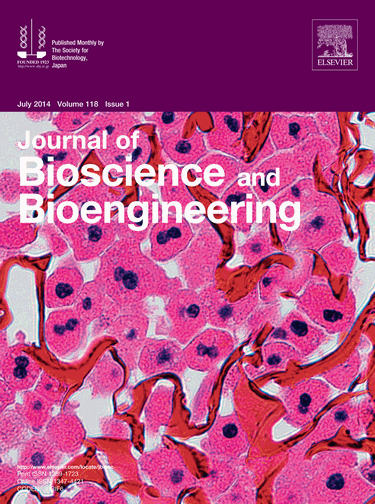
A novel intelligent galactosylated-chitosan/hyaluronic acid hybrid sponge was developed for use in a dense co-culture system designed to simulate the liver microenvironment. The hematoxylin and eosin staining indicates that murine primary hepatocytes and human endothelial cells adhered to the sponges and formed clusters.
For more information regarding this work, read the article: Shang et al., “Hybrid sponge comprised of galactosylated chitosan and hyaluronic acid mediates the co-culture of hepatocytes and endothelial cells”, J. Biosci. Bioeng., volume 117, issue 1, pages 99–106 (2014).
⇒JBBアーカイブ:Vol.107 (2009) ~最新号
⇒JBBアーカイブ:Vol. 93(2002)~Vol. 106(2008)
Journal of Bioscience and Bioengineering
Published by 学会事務局 on 14 12月 2013
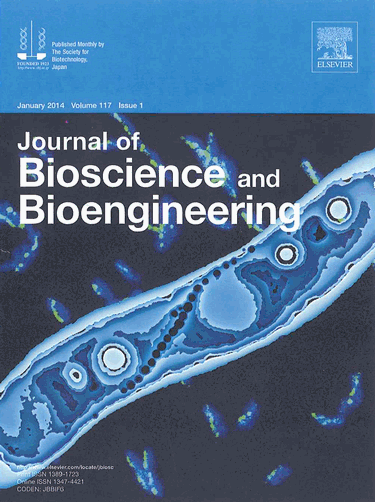
Bacterial magnetic particles (BacMPs) are ultrafine nano-sized magnetite crystals produced by magnetotactic bacteria, Magnetospirillum magneticum AMB-1. The techniques of functional protein display onto BacMPs by genetic engineering have been developed, and a variety of biomedical and environmental applications has been demonstrated. However, recombinant human proteins are often poorly expressed on BacMPs because of proteolytic degradation by endogenous proteases. In this study, to improve the amount of displayed heterologous proteins onto BacMPs, Kanetsuki et al. constructed lon gene deletion mutant (Δlon) strain. Consequently, the expression of target proteins was increased significantly in the Δlon strain. The constructed strain would be an efficient strain to display of heterologous proteins on BacMPs, and a useful tool for various applications.
For more information regarding this work, read the article: Kanetsuki et al., “Enhanced heterologous protein display on bacterial magnetic particles using a lon protease gene deletion mutant in Magnetospirillum magneticum AMB-1″, J. Biosci. Bioeng., volume 116, issue 1, pages 65–70 (2013).
⇒JBBアーカイブ:Vol.107 (2009) ~最新号
⇒JBBアーカイブ:Vol. 93(2002)~Vol. 106(2008)
Journal of Bioscience and Bioengineering
Published by 学会事務局 on 30 5月 2013
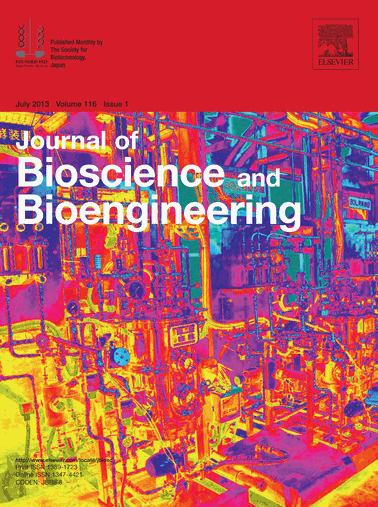
In order to design a sustainable low-carbon society, Green Innovation shifting from oil-refinery to bio-refinery should be significantly important. Biorefinery is an excellent technology to produce biofuels, bio-plastics, bio-fibers, and bio-chemicals from biomass using carbon dioxide as a recyclable resource.
Bioprocess engineering is one of the most important mass-production technologies using cell factories, which can help produce various target products directly from pretreated biomass. To improve the productivity, it is essential to optimize conditions under large-scale culture. Since pre-treated biomass contains fermentation inhibitors and high-density solid biomass such as lignin, the control of fermentation process is one of the key factors for efficient fermentation.
Biorefinery Group of Kobe University led by Prof. Akihiko Kondo aims to optimize the large-scale fermentation as well as total process of biorefinery.
⇒JBBアーカイブ:Vol.107 (2009) ~最新号
⇒JBBアーカイブ:Vol. 93(2002)~Vol. 106(2008)
Journal of Bioscience and Bioengineering
Published by 学会事務局 on 19 11月 2012
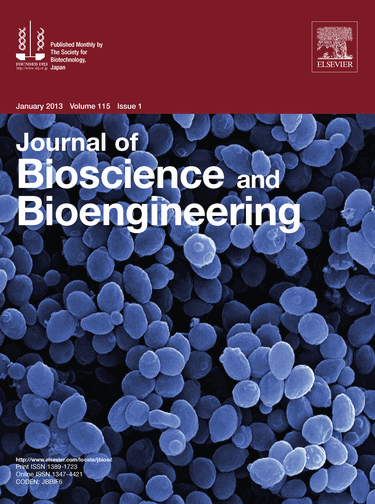
Saccharomyces cerevisiae M30 and Kluyveromyces marxianus DMKU 3-1042 were isolated at Department of Microbiology, Kasetsart University (Bangkok, Thailand) on the basis of its high efficiency in ethanol production at high temperature. Suspended and immobilized cocultures of the thermotolerant yeast, K. marxianus DMKU 3-1042 and the mesophilic flocculent yeast, S. cerevisiae M30 were studied for their abilities to improve production and stability of ethanol fermentation. The results indicated that the coculture system could improve ethanol production from both sugarcane juice and blackstrap molasses when the operating temperature ranged between 33°C and 45°C. High temperature tolerances were achieved when the coculture was immobilized. This photograph was taken at Scientific and Technological Research Equipment Centre, Chulalongkorn University (Bangkok, Thailand).
For more information regarding this work, read the article: Eiadpum, A., Limtong, S., and Phisalaphong, M., “High-temperature ethanol fermentation by immobilized coculture of Kluyveromyces marxianus and Saccharomyces cerevisiae“, J. Biosci. Bioeng., volume 114, issue 3, pages 325–329 (2012).
⇒JBBアーカイブ:Vol.107 (2009) ~最新号
⇒JBBアーカイブ:Vol. 93(2002)~Vol. 106(2008)
Journal of Bioscience and Bioengineering
Published by 学会事務局 on 24 6月 2012
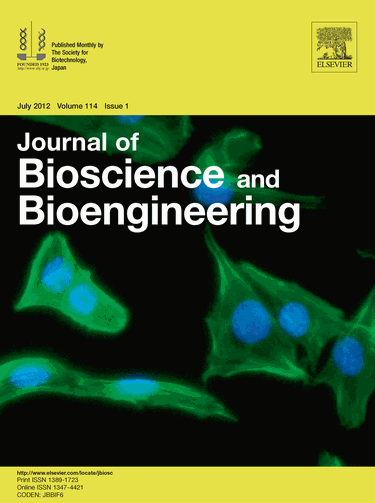
Actin and nuclei staining of C2C12 myoblasts that underwent stimulation at increasing values of gravity force. Actin staining was performed on treated samples immediately fixed after the hypergravity exposure. The organization of actin microfilament network in treated and non-treated cells was evaluated by f-actin staining with FITC-phalloidin (green), while nuclei were counte stained with DAPI (blue). It has been demonstrated that hypergravity strongly affects the reorganization of f-actin filaments: an increment filament thickness was evident at higher g values, compatible with a rearrangement of the cell structures. This photograph was taken at the Center for Micro-BioRobotics@SSSA of the Italian Institute of Technology, Pontedera (Pisa), Italy.
For more information regarding this work, read the article: Ciofani, G. et al., “Hypergravity effects on myoblast proliferation and differentiation”, J. Biosci. Bioeng., volume 113, issue 2, pages 258–261 (2012).
⇒JBBアーカイブ:Vol.107 (2009) ~最新号
⇒JBBアーカイブ:Vol. 93(2002)~Vol. 106(2008)
Journal of Bioscience and Bioengineering
Published by 学会事務局 on 06 1月 2012
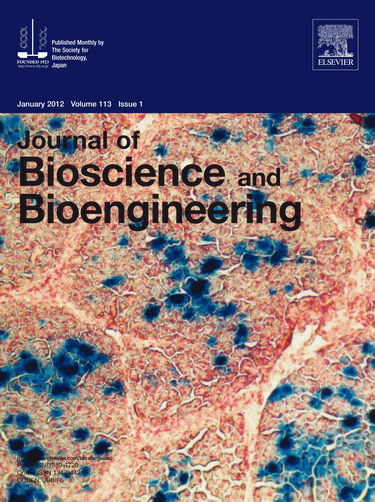
Reporter gene lac-z expression using adenoviral vector AdβGal in experimental liver fibrosis. Slide showing the expression of β-galactosidase in a liver section from a CCl4 chronically intoxicated rat during eight weeks. Liver samples were cut utilizing a cryostat system 72 h after systemic administration of 2 x 10e11 total IU of AdβGal. Analysis of protein expression was performed using X-gal reagent and counterstaining with neutral red. Blue cells show the expression of β-galactosidase protein from AdβGal vector indicating that therapeutic genes can be useful to remove liver fibrosis. This photograph was taken in the Institute of Molecular Medicine and Gene Therapy from the University of Guadalajara, Guadalajara, Jalisco, Mexico.
For more information regarding this work, read the article: Armendariz-Borunda, J. et al., “Production of first generation adenoviral vectors for preclinical protocols: Amplification, purification and functional titration”, J. Biosci. Bioeng., volume 112, issue 5, pages 415-421 (2011).
⇒JBBアーカイブ:Vol.107 (2009) ~最新号
⇒JBBアーカイブ:Vol. 93(2002)~Vol. 106(2008)
Journal of Bioscience and Bioengineering
Published by 学会事務局 on 12 7月 2011
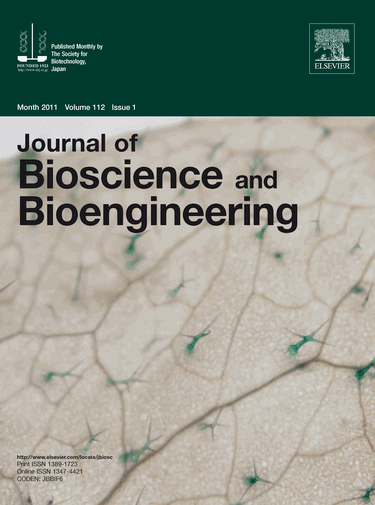
Plants produce a wide variety of isoprenoid compounds. Sesquiterpenes, triterpenes, and sterols are biosynthesized via the mevalonate (MVA) pathway. The enzyme 3-hydroxy-3-methylglutaryl-CoA reductase (HMGR) catalyzes the first rate-limiting step in the MVA pathway. The model plant Arabidopsis thaliana contains two differentially expressed HMGR genes, HMG1 and HMG2. Histochemical GUS staining of transgenic plants carrying promoter::GUS reporter fusions showed that HMG1 is expressed mainly in veins, but HMG2 is expressed exclusively in three-branched trichomes (picture) that differentiate from single epidermal cells on the leaves.
The image was provided by Dr. Hikaru Seki at Plant Metabolism and Cell Technology Laboratory, Department of Biotechnology, Graduate School of Engineering, Osaka University.
⇒JBBアーカイブ:Vol.107 (2009) ~最新号
⇒JBBアーカイブ:Vol. 93(2002)~Vol. 106(2008)
Journal of Bioscience and Bioengineering
Published by 学会事務局 on 28 1月 2011
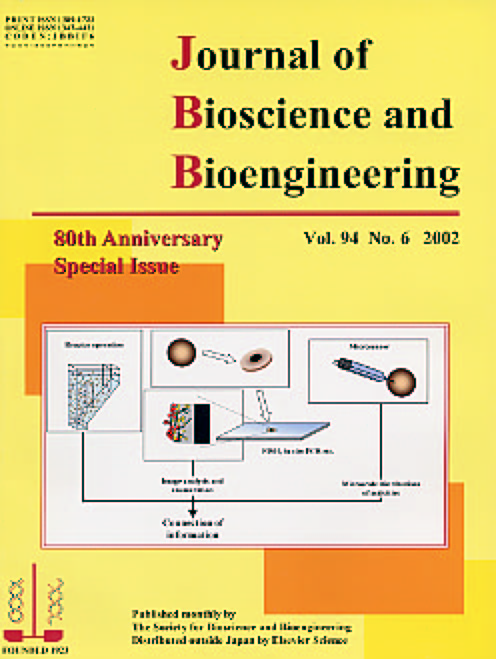
Y. Aoi review the in situ identification of microorganisms in biofilm communities both in natural environments and in engineered systems such as wastewater treatment processes. This figure shows analysis of the in situ organization of a biofilm community using various methods and the connection with reactor performance.
Related article: Aoi, Y., “In situ identification of microorganisms in biofilm communities“, J. Biosci. Bioeng., vol. 94, 552-556 (2002).
⇒JBBアーカイブ:Vol.107 (2009) ~最新号
⇒JBBアーカイブ:Vol. 93(2002)~Vol. 106(2008)
Journal of Bioscience and Bioengineering
Published by 学会事務局 on 28 1月 2011
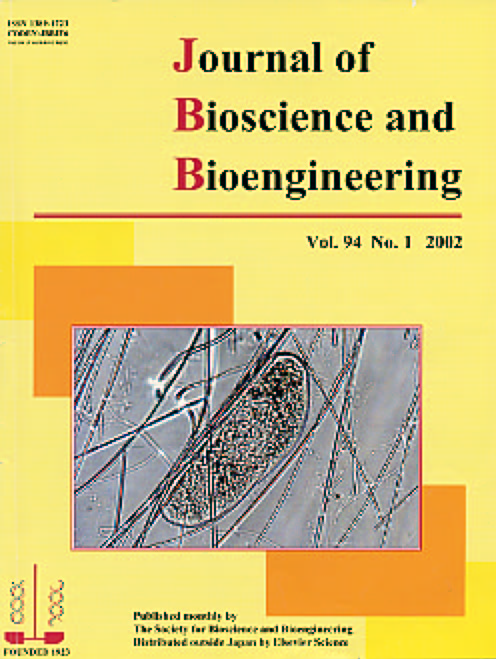
Takiguchi et al. found that the ciliated protozoan Paramecium caudatum ON-1 was repelled by 2,4-dichlorophenoxyacetic acid (2,4-D). The figure shows that after retarding the cell’s movement with glass fibers, a KCl-filled microelectrode was slowly inserted into the midsection of the cell on the coverslip by using a three-axis oil hydraulic micromanipulator.
Related article: Takiguchi et al., “Behavioral responses of the ciliated protozoan Paramecium caudatum to 2,4-dichlorophenoxyacetic acid and its analogues“, J. Biosci. Bioeng., vol. 93, 416-420 (2002).
⇒JBBアーカイブ:Vol.107 (2009) ~最新号
⇒JBBアーカイブ:Vol. 93(2002)~Vol. 106(2008)
Journal of Bioscience and Bioengineering
Published by 学会事務局 on 28 1月 2011
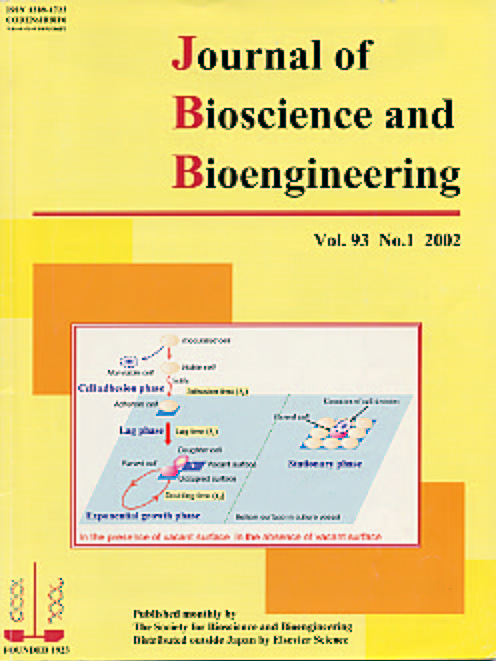
Schematic drawing of the process of culturing monolayer keratinocytes in the presence and absence of vacant surface.
Related article: Kino-oka et al., “Valuation of growth parameters in monolayer keratinocyte cultures based on a two-dimensional cell placement model“, J. Biosci. Bioeng., vol. 89, 285-287 (2000).
⇒JBBアーカイブ:Vol.107 (2009) ~最新号
⇒JBBアーカイブ:Vol. 93(2002)~Vol. 106(2008)
Journal of Bioscience and Bioengineering
Published by 学会事務局 on 28 1月 2011

Flagellin as a cell surface protein with alginate-binding activity.
Immunogold electron microscopy showing the specific expression and localization of flagellin on the surface of macromolecule (alginate)-grown cells (right, above) of Sphingomonas sp. strain A1, an unflagellated and pit-forming bacterium (left) found for the first time in the history of microbiology, is presented in comparison with that of yeast extract-grown cells (right, below). Flagellin is also shown to be able to bind alginate strongly and specifically, and to regulate cell surface structure. These findings are exciting and provide significant insights into the origin, evolution, and novel function of flagellin unrelated to flagella.
Related article: Hashimoto, W., Yamasaki, M., Itoh, T., Momma, K., Mikami, B., and Murata, K., “Super-channel in bacteria: structural and functional aspects of a novel biosystem for the import and depolymerization of macromolecules“, J. Biosci. Bioeng., vol. 98, 399–413 (2004).
⇒JBBアーカイブ:Vol.107 (2009) ~最新号
⇒JBBアーカイブ:Vol. 93(2002)~Vol. 106(2008)
Journal of Bioscience and Bioengineering
Published by 学会事務局 on 28 1月 2011
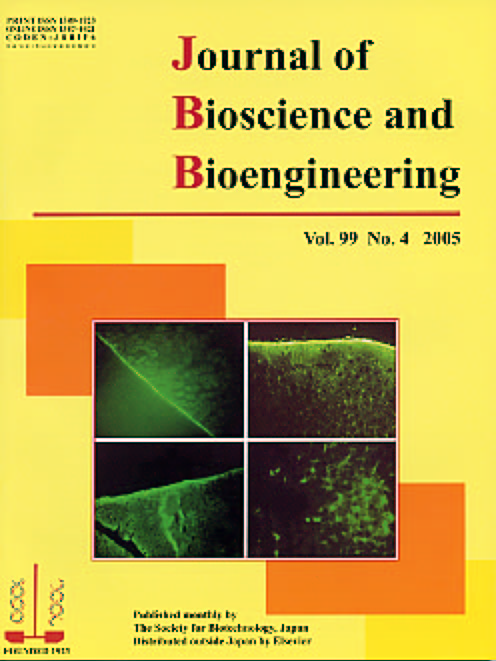
An efficient method for delivery of proteins into living cells.
A novel method for delivering functional proteins into living cells involving proteins cationized with polyethylenimine (PEI) was presented. The photos on the cover show the transduction of PEI-cationized green fluorescent protein (GEP) into mouse kidney (above left), peritoneum (above right), and liver (below left), which was analyzed by fluorescence micrography of tissue sections. Other than GFP, PEI-cationized RNase (ribonuclease) and PEI-cationized immunoglobulin (IgG) were also incorporated into the cells, in receptor- and transporter-independent manners, and functioned in the cytosol, suggesting the usefulness of this method for the development of protein transduction technology in the post-genomic era.
Related article: Futami, J., Kitazoe, M., Maeda, T., Nukui, E., Sakaguchi, M., Kosaka, J., Miyazaki, M., Kosaka, M., Tada, H., Seno, M., Sasaki, J., Huh, N.-H., Namba, M., and Yamada, H., “Intracellular delivery of proteins into mammalian living cells by polyethylenimine-cationization“, J. Biosci. Bioeng., vol. 99, 95–103 (2005).
⇒JBBアーカイブ:Vol.107 (2009) ~最新号
⇒JBBアーカイブ:Vol. 93(2002)~Vol. 106(2008)
Journal of Bioscience and Bioengineering
Published by 学会事務局 on 28 1月 2011
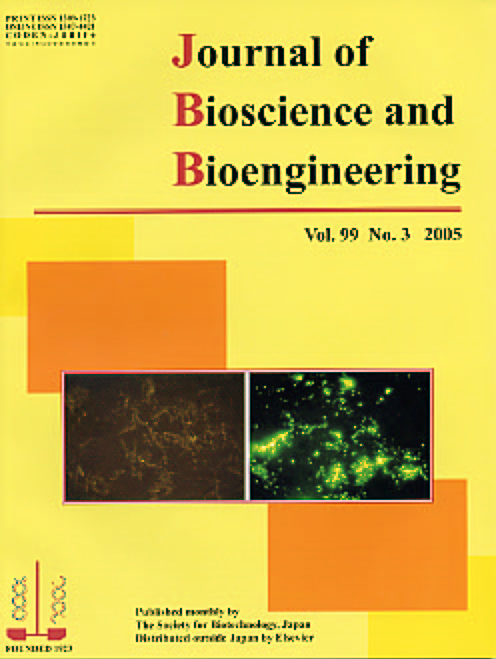
Epifluorescence micrographs of anaerobic sludge.
Tyramide signal amplification (TSA) system was used in combination with a conventional fluorochrome-labeled 16S rRNA oligonucleotide probe to increase the sensitivity of fluorescence in situ hybridization (FISH), which is frequently used in various fields of microbiology. The fluorescence signal of the probe obtained using the TSA system (right panel) was much higher than that obtained in the absence of the system (left panel), indicating that the TSA-dependent technique is readily applicable to the in situ detection of microbial communities, for example, in anaerobic sludge.
Related article: Jupraputtasri, W., Cheevadhanarak, S., Chaiprasert, P., Tanticharoen, M., and Techkarnjanaruk, S., “Use of fluorochrome-labeled rRNA targeted oligonucleotide probe and tyramide signal amplification to improve sensitivity of fluorescence in situ hybridization“, J. Biosci. Bioeng., vol. 98, 282-286 (2004).
⇒JBBアーカイブ:Vol.107 (2009) ~最新号
⇒JBBアーカイブ:Vol. 93(2002)~Vol. 106(2008)
Journal of Bioscience and Bioengineering
Published by 学会事務局 on 28 1月 2011
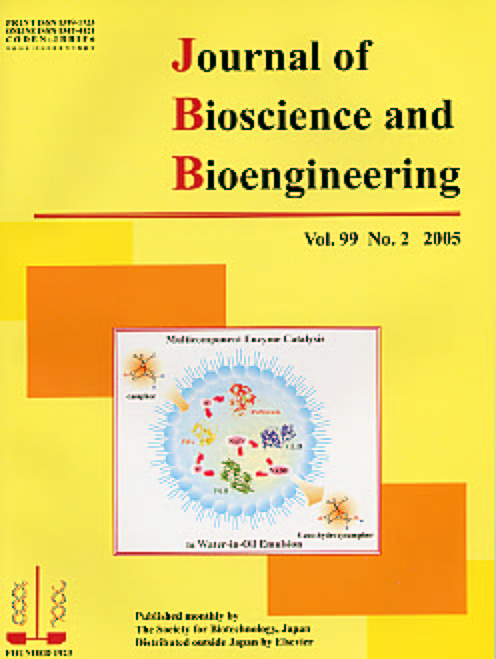
Functionalization of the cytochrome P450cam monooxygenase system.
Functionalization of the cytochrome P450cam monooxygenase system, which requires electron transfer among three different proteins, was successfully attained in the micro-scale aqueous compartments of stable water-in-oil (W/O) emulsions, which can be easily formed by mixing organic and aqueous solutions. The activity of the cytochrome P450 monooxygenase system as to hydroxylation of camphor, as a model, was efficiently improved through coupling of the system with the NADH regeneration process, as illustrated on the cover of this issue, suggesting the potential utility of the micro-scale cell-like aqueous compartments of W/O emulsions for practical multicomponent enzymatic reactions, especially for substrates with low aqueous solubility.
Related article: Michizoe, J., Ichinose, H., Kamiya, N., Maruyama, T., and Goto, M., “Functionalization of the cytochrome P450cam monooxygenase system in the cell-like aqueous compartments of water-in-oil emulsions“, J. Biosci. Bioeng., vol. 99, 12-17 (2005).
⇒JBBアーカイブ:Vol.107 (2009) ~最新号
⇒JBBアーカイブ:Vol. 93(2002)~Vol. 106(2008)
Journal of Bioscience and Bioengineering
Published by 学会事務局 on 28 1月 2011
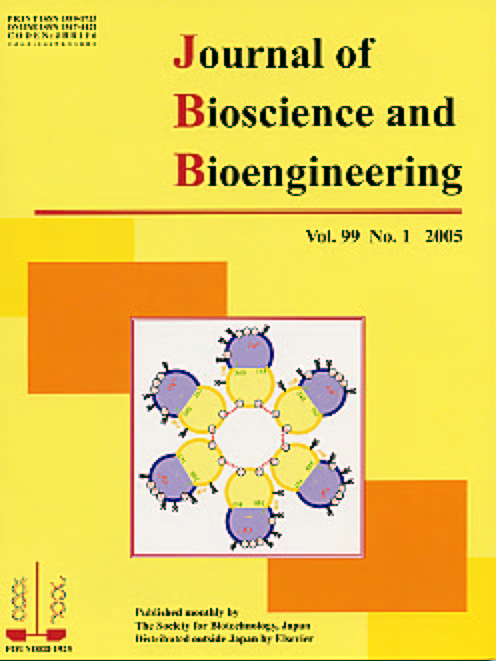
A model for the structure of a novel lectin, PCL-M.
Pleurotus cornucopiae synthesizes two types of lectins, PCL-F and PCL-M, in a developmental-stage-specific manner. The former occurs in a fruiting body, and the latter does only in a solid-grown mycelial aggregate and appears just prior to fruiting body formation, indicating the participation of PCL-M in the process of fruiting body formation. The most active form of PLC-M is composed of an oligomer (hexamer to octamer) of the subunits linked through disulfide bonds.
Related article: Sumisa, F., Ichijo, N., Yamaguchi, H., Nakatsumi, H., Ando, A., Iijima, N., Oguri, S., Uehara, K., and Nagata, Y., “Molecular properties of mycelial aggregate-specific lectin of Pleurotus cornucopiae“, J. Biosci. Bioeng., vol. 98, 257-262 (2004).
⇒JBBアーカイブ:Vol.107 (2009) ~最新号
⇒JBBアーカイブ:Vol. 93(2002)~Vol. 106(2008)
Journal of Bioscience and Bioengineering
Published by 学会事務局 on 28 1月 2011
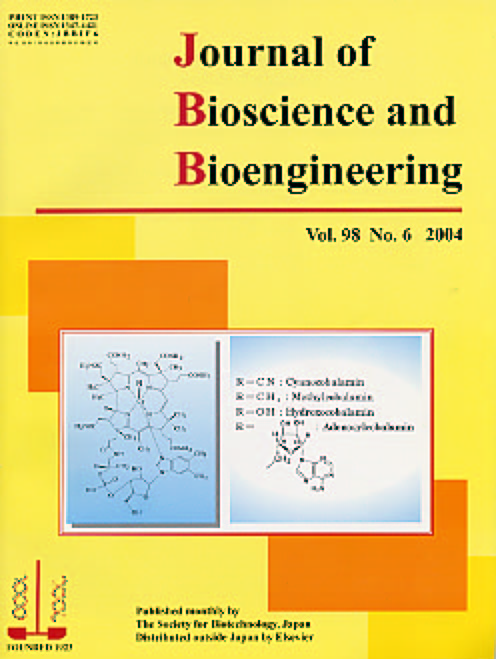
Structure of vitamin B12 (cyanocobalamin).
To increase the production of the vitamin by Propionibacterium freudenreichii, a known producer of this important vitamin in medical and food areas, more than 10 genes belonging to the hem, cob and cbi gene families involved in the vitamin B12 synthetic pathway of P. freudenreichii and other bacteria were overexpressed in the bacterium, and approximately 2-fold higher productivity was attained, confirming the greater usefulness of the bacterium for the production of vitamin B12 compared to chemical synthesis, which requires more than 70 complicated steps.
Related article: Piao, Y., Yamashita, M., Kawaraichi, N., Asegawa, R., Ono, H., and Murooka, Y., “Production of vitamin B12 in genetically engineered Propionibacterium freundenreichii“, J. Biosci. Bioeng., vol. 98, 167-173 (2004).
⇒JBBアーカイブ:Vol.107 (2009) ~最新号
⇒JBBアーカイブ:Vol. 93(2002)~Vol. 106(2008)
Journal of Bioscience and Bioengineering
Published by 学会事務局 on 28 1月 2011
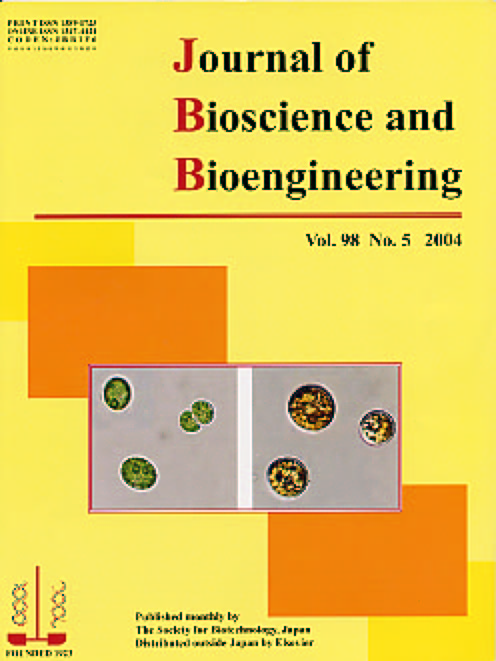
Optical micrographs of cells of aerial microalga Coelastrella striolata var. multistriata cultured with (left panel) or without (right panel) a nitrogen source.
The cells of the microalga exhibit abilities to be reddish orange (right panel) to green (left panel), depending on the nitrogen source and have the ability to remove environmental nitrogen, suggesting the usefulness of such a photosynthetic microorganism for environmental biomonitoring and remediation.
Related article: Abe, K., Takizawa, H., Kimura, S., and Hirano, M., “Characteristics of chlorophyll formation of the aerial microalga Coelastrella striolata var. multistriata and its application for environmental biomonitoring“, J. Biosci. Bioeng., vol. 98, 34-39 (2004).
⇒JBBアーカイブ:Vol.107 (2009) ~最新号
⇒JBBアーカイブ:Vol. 93(2002)~Vol. 106(2008)
Journal of Bioscience and Bioengineering
Published by 学会事務局 on 28 1月 2011
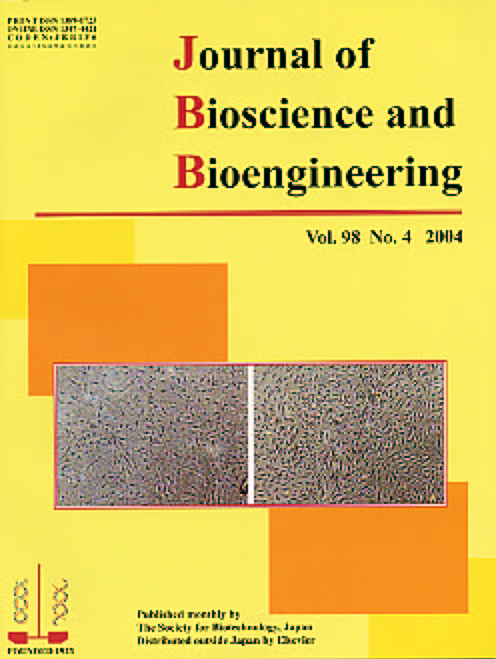
Inverted light micrographs of human periodontal ligament cells on porcine atelocollagen (left panel, incubated for 3 d) and 1-ethyl-3-(3-dimethylaminopropyl)-carbodiimide (EDC) cross-linked salmon atelocollagen (SC) (right panel, incubated for 3 d).
The treatment of SC with EDC highly improved the thermostability of SC and the proliferative potential of the human cells, suggesting the EDC cross-linked SC fibrillar gel can be utilized for the development of cellular matrices and tissue engineering.
Related article: Yunoki, S., Nagai, N., Suzuki, T., and Munekata, T., “Novel biomaterial from reinforced salmon collagen gel prepared by fibril formation and cross-linking“, J. Biosci. Bioeng., vol. 98, 40-47 (2004).
⇒JBBアーカイブ:Vol.107 (2009) ~最新号
⇒JBBアーカイブ:Vol. 93(2002)~Vol. 106(2008)
Journal of Bioscience and Bioengineering
Published by 学会事務局 on 28 1月 2011
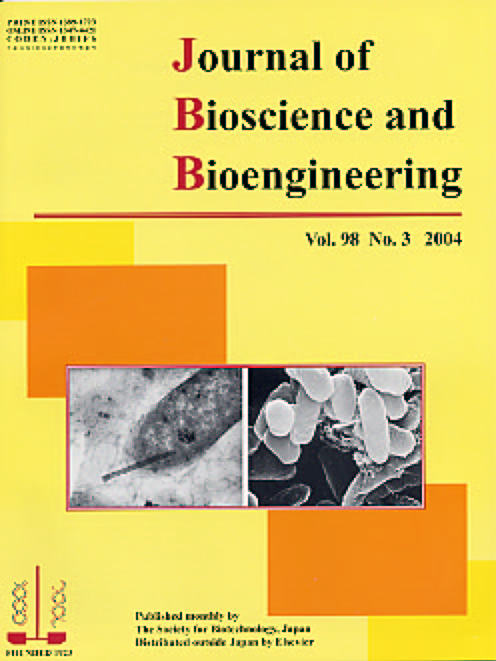
Transmission- (left) and scanning-electron-microscopy (right) photographs showing the penetration of chrysolite fibers into Escherichia coli cells under the sliding friction force. By using the fibers coated with DNAs, bacterial cells are expected to be efficiently transformed.
Related article: Yoshida, N. and Saeki, Y., “Chrysotile fibers penetrate Escherichia coli cell membrane and cause cell bursting by sliding friction force on agar plates“, J. Biosci. Bioeng., vol. 97, 162-168 (2004).
⇒JBBアーカイブ:Vol.107 (2009) ~最新号
⇒JBBアーカイブ:Vol. 93(2002)~Vol. 106(2008)
Journal of Bioscience and Bioengineering
Published by 学会事務局 on 28 1月 2011
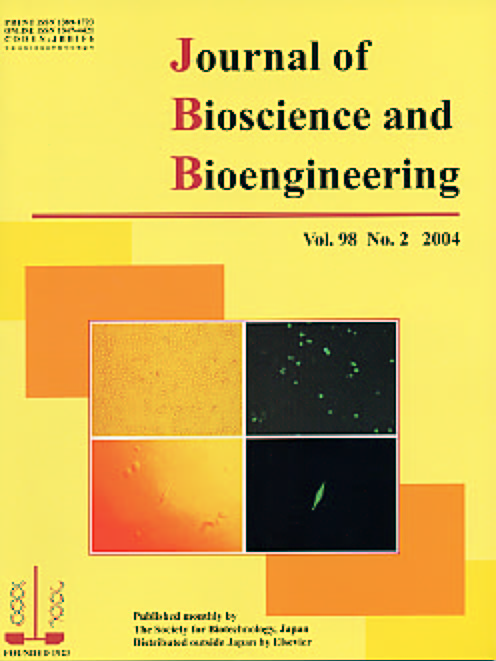
Transfection of mammalian cells, human lymphocytes (above) and human carcinoma HeLa cells (below), by means of calcium alginate microbeads bearing immobilized DNAs. Phase-contrast micrographs (left panel), and fluorescent micrographs (right panel) show expression of the pEGFP-C1 plasmid containing the CMV promoter and the EGFP gene.
Related article: Higashi, T., Nagamori, E., Sone, T., Matsunaga, S., and Fukui, K., “A novel transfection method for mammalian cells using calcium alginate microbeads“, J. Biosci. Bioeng., vol. 97, 191-195 (2004).
⇒JBBアーカイブ:Vol.107 (2009) ~最新号
⇒JBBアーカイブ:Vol. 93(2002)~Vol. 106(2008)
Journal of Bioscience and Bioengineering
Published by 学会事務局 on 28 1月 2011

Schematic diagram of the secretory characteristics of Saccharomyces cerevisiae protoplasts inferred from DNA microarray results. The secretory pathway in protoplasts (right panel: red arrows) is significantly activated in protoplasts compared to in intact cells (left panel), implying the usefulness of protoplasts for the production of enzymes.
Related article: Mera, N., Aoyagi, H., Nakasono, S., Iwasaki, K., Sakai, H., and Tanaka, H., “Analysis of gene expression in yeast protoplasts using DNA microarrays and their application for efficient production of invertase and α-glucosidase“, J. Biosci. Bioeng., vol. 97, 169-183 (2004).
⇒JBBアーカイブ:Vol.107 (2009) ~最新号
⇒JBBアーカイブ:Vol. 93(2002)~Vol. 106(2008)
Journal of Bioscience and Bioengineering
Published by 学会事務局 on 28 1月 2011
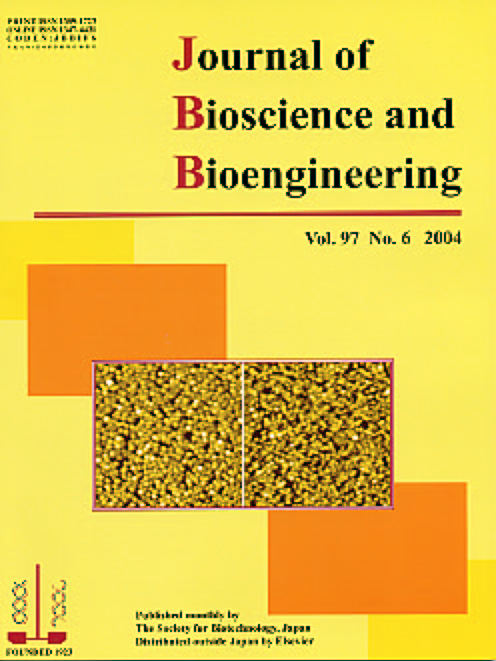
Typical atomic force microscopy images of the streptavidin layers adsorbed on a mica surface (left panel) and the pretreated gold surface (right panel) in the originally scanned 1 x 1 μm2 areas.
Related article: Kim, J., Yamasaki, R., Park, J., Jung, H., Lee, H., and Kawai, T., “Highly dense protein layers confirmed by atomic force microscopy and quartz crystal microbalance“, J. Biosci. Bioeng., vol. 97, 138-140 (2004).
⇒JBBアーカイブ:Vol.107 (2009) ~最新号
⇒JBBアーカイブ:Vol. 93(2002)~Vol. 106(2008)
Journal of Bioscience and Bioengineering
Published by 学会事務局 on 28 1月 2011
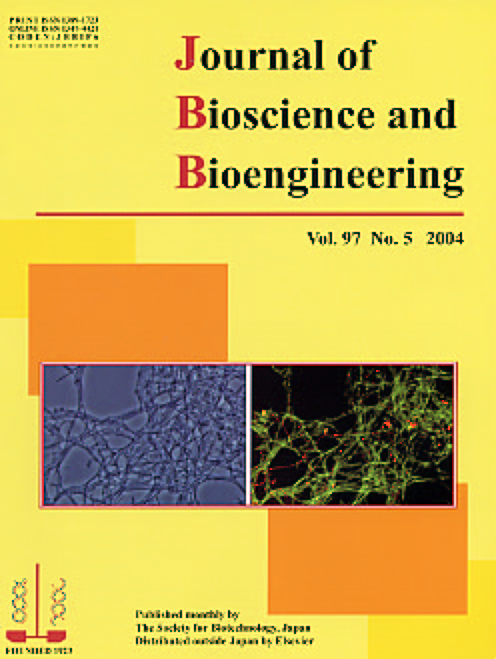
Photomicrographs of contrast view (left panel) and FISH result (right panel) for the acetate-degrading methanogenic communities.
Related article: Shigematsu, T., Tang, Y., Kawaguchi, H., Ninomiya, K., Kijima, J., Kobayashi, T., Morimura, S., and Kida, K., “Effect of dilution rate on structure of a mesophilic acetate-degrading methanogenic community during continuous cultivation“, J. Biosci. Bioeng., vol. 96, 547-558 (2003).
⇒JBBアーカイブ:Vol.107 (2009) ~最新号
⇒JBBアーカイブ:Vol. 93(2002)~Vol. 106(2008)
Journal of Bioscience and Bioengineering
Published by 学会事務局 on 28 1月 2011
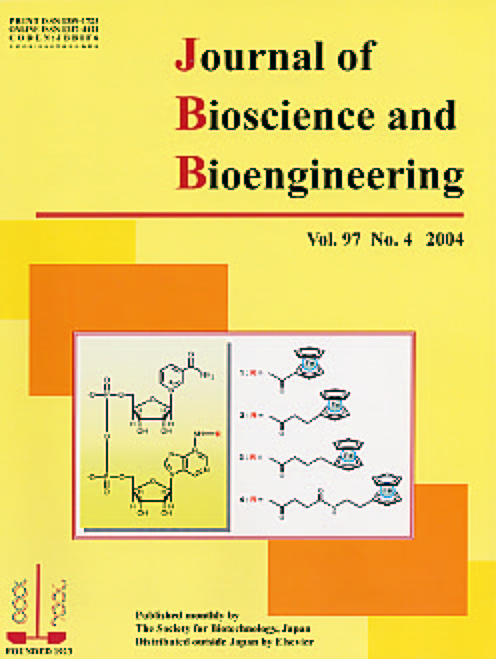
Ferrocene-labeled NAD which has a biological activity as substrate in the alcohol dehydrogenase system. Left and right panels show NAD moiety and ferrocene moiety, respectively.
Related article: Kijima, T., Suzuki, T., and Izumi, T., “Electrical communication between NAD-dependent enzyme and metal electrode using ferrocene-labeled NAD derivatives“, J. Biosci. Bioeng., vol. 96, 585-587 (2003).
⇒JBBアーカイブ:Vol.107 (2009) ~最新号
⇒JBBアーカイブ:Vol. 93(2002)~Vol. 106(2008)
Journal of Bioscience and Bioengineering
Published by 学会事務局 on 28 1月 2011
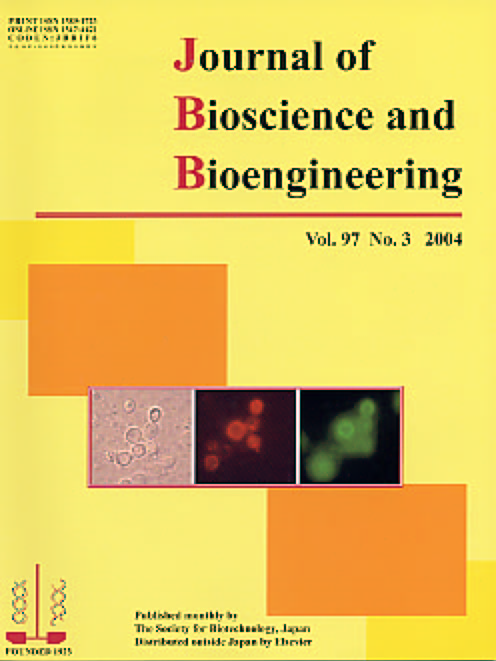
Microscopic observation of yeast strains.
Phase-contrast micrograph (left panel), immunofluorescence micrograph showing ZZ displayed on the cell surface by labeling with rabbit IgG and goat antirabbit IgG conjugated with Alexa Fluor 546 (middle panel), and fluorescence micrograph showing the fluorescence of GFP displayed on the cell surface (right panel).
Related article: Shimojyo, R., Furukawa, H., Fukuda, H., and Kondo, A., “Preparation of yeast strains displaying IgG binding domain ZZ and enhanced green fluorescent protein for novel antigen detection systems“, J. Biosci. Bioeng., vol. 96, 493-495 (2003).
⇒JBBアーカイブ:Vol.107 (2009) ~最新号
⇒JBBアーカイブ:Vol. 93(2002)~Vol. 106(2008)
Journal of Bioscience and Bioengineering
Published by 学会事務局 on 28 1月 2011
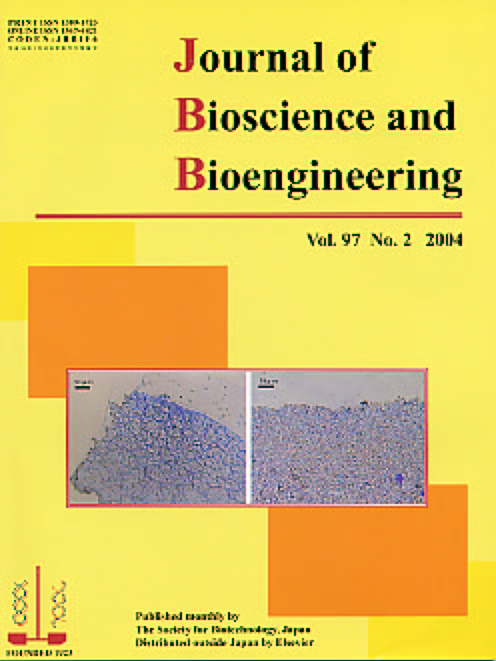
Light microscopic images of 70% polished rice endosperm of low-glutelin rice of Tashu-kei 1001 (left panel) and Hyogokitanishiki (right panel). These rices are often used as a raw material for brewing Japanese sake. Storage proteins are stained blue with CBB. The starch granules appear as white spheres.
Related article: Furukawa, S., Mizuma, T., Kiyokawa, Y., Masumura, T., Tanaka, K., and Wakai, Y., “Distribution of storage proteins in low-glutelin rice seed determined using a fluorescent antibody“, J. Biosci. Bioeng., vol. 96, 467-476 (2003).
⇒JBBアーカイブ:Vol.107 (2009) ~最新号
⇒JBBアーカイブ:Vol. 93(2002)~Vol. 106(2008)
Journal of Bioscience and Bioengineering
Published by 学会事務局 on 28 1月 2011
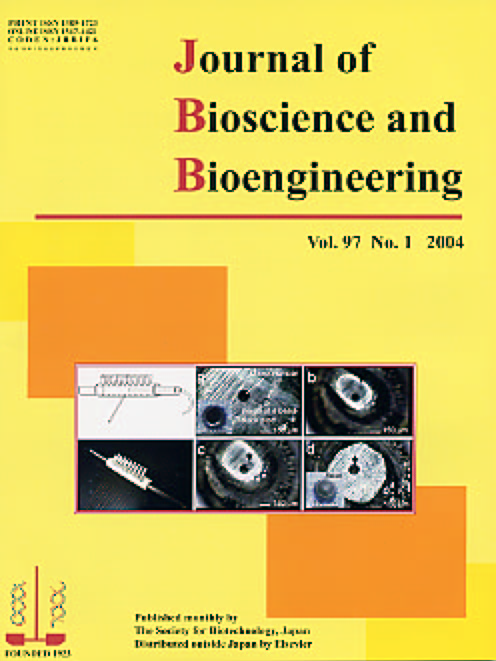
A novel bead-alignment device and images of a single bead traveling from a bead stocker to the microchamber. White arrow indicates the movement of the bead as it is trapped in the microchamber. Insets a and d are magnified images of the microchamber before and after capturing a single bead.
Related article: Noda, H., Kaise, M., Kohara, Y., Okano, K., and Kambara, H., “A bead-alignment device with a bead-sized microchamber on a rotating cylinder for fabrication of a miniaturized probe array“, J. Biosci. Bioeng., vol. 96, 86-88 (2003).
⇒JBBアーカイブ:Vol.107 (2009) ~最新号
⇒JBBアーカイブ:Vol. 93(2002)~Vol. 106(2008)
Journal of Bioscience and Bioengineering
Published by 学会事務局 on 28 1月 2011
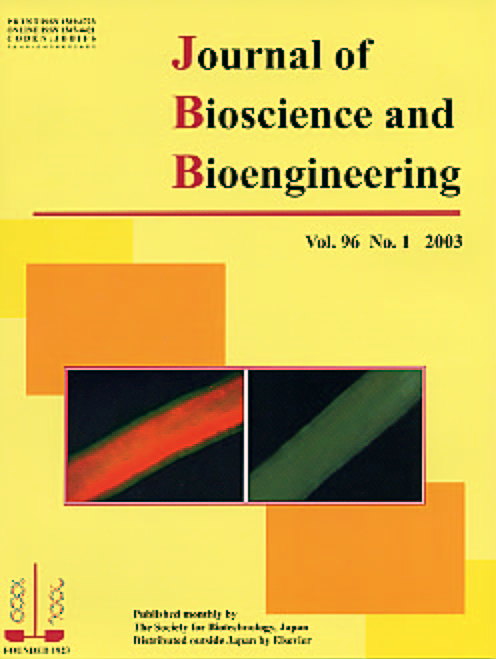
Fluorescent images of photoautotrophic hairy roots, culture with (right panel) and without paraquat (left panel).
Related article: Ninomiya, K., Oogami, Y., Kino-oka, M., and Taya, M., “Assessment of herbicidal toxicity based on non-destructive measurement of local chlorophyll content in photoautotrophic hairy roots“, J. Biosci. Bioeng., vol. 95, 264-270 (2003).
⇒JBBアーカイブ:Vol.107 (2009) ~最新号
⇒JBBアーカイブ:Vol. 93(2002)~Vol. 106(2008)
Journal of Bioscience and Bioengineering
Published by 学会事務局 on 28 1月 2011
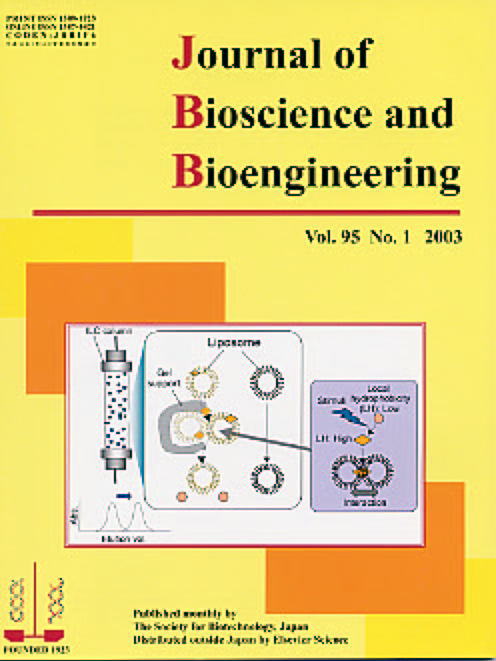
Conceptual scheme of the immobilized liposome chromatography for the evaluation of membrane-membrane interaction by stimuli responsive polymer and protein.
Related article: Felix, M. M., Umakoshi, H., Shimanouchi, T., Yoshimoto, M., and Kuboi, R., “Evaluation of interaction between liposome membranes induced by stimuli responsive polymer and protein“, J. Biosci. Bioeng., vol. 93, 498-501 (2002).
⇒JBBアーカイブ:Vol.107 (2009) ~最新号
⇒JBBアーカイブ:Vol. 93(2002)~Vol. 106(2008)
Journal of Bioscience and Bioengineering
Published by 学会事務局 on 28 1月 2011
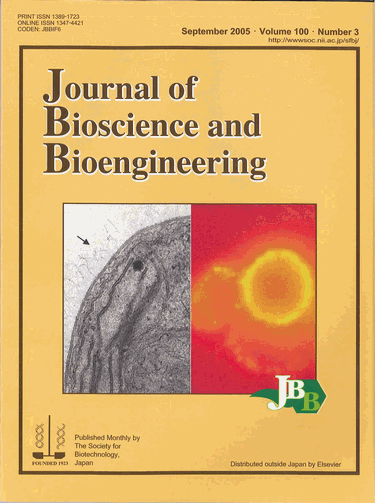
New approaches for microbial synthesis of chitin and hyaluronan.
A novel method for synthesizing chitin was presented. Some chloroviruses have a gene for functional chitin synthase and produce chitin fibers surrounding the external surface of infected Chlorella cells. The photos of the cover show the chitin accumulation on the CVK2-infected Chlorella cells revealed by electron micrograph (left, indicated by an arrow) and fluoromicroscopy treated with biotin-chitin-binding protein and avidin-Cy3 conjugates (right).
Chitin fibers are loosely associated with the host cell wall matrix and can be easily released by vortexing or ultrasonication. Similar method was also applied to the production of hyaluronan using the Chlorella-virus system, which has some advantages: recovery is easy, pathogen factor is avoided, clean light energy and CO2 are utilized, and high molecular weight polysaccharide is obtained.
Related article: Yamada, T. and Kawasaki, T., “Microbial synthesis of hyaluronan and chitin: new approaches“, J. Biosci. Bioeng., vol. 99, 521-528 (2005).
⇒JBBアーカイブ:Vol.107 (2009) ~最新号
⇒JBBアーカイブ:Vol. 93(2002)~Vol. 106(2008)
Journal of Bioscience and Bioengineering
Published by 学会事務局 on 28 1月 2011
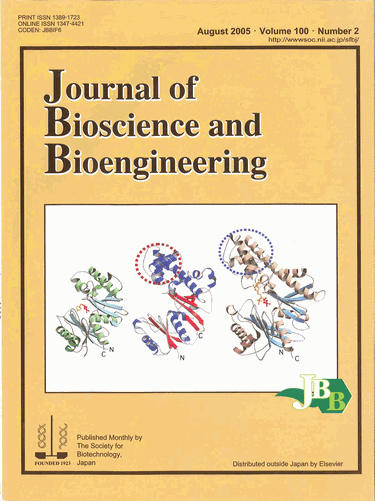
Hypothesis on the evolution of glucose kinases.
A putative evolutionary process for glucose kinases through the acquisition of flexible subdomains, which are enclosed by dotted lines, was postulated based on the three-dimensional structures of Arthrobacter sp. KM1 inorganic polyphosphate/ATP-glucomannokinase (left), Escherichia coli ATP-specific glucokinase (middle), and human ATP-specific hexokinase (right).
The hypothesis emphasizes that glucose kinases evolved from an ancestral “polyphosphate/ATP-dependent glucokinase” into an ATP-specific hexokinase, via an ATP-specific glucokinase, thereby losing polyphosphate-utilizing capability and acquiring flexible subdomains of increasing sizes, which enable enzymes to be regulated more precisely and ingeniously.
Related article: Kawai, S., Mukai, T., Mori, S., Mikami, B., and Murata, K., “Hypothesis: structure, evolution, and ancestor of glucose kinases in the hexokinase family“, J. Biosci. Bioeng., vol. 99, 320-330 (2005).
⇒JBBアーカイブ:Vol.107 (2009) ~最新号
⇒JBBアーカイブ:Vol. 93(2002)~Vol. 106(2008)
Journal of Bioscience and Bioengineering
Published by 学会事務局 on 28 1月 2011
創刊100号記念特集 Vol. 100, July 2005
“Advances in Biomedical Science and Engineering”
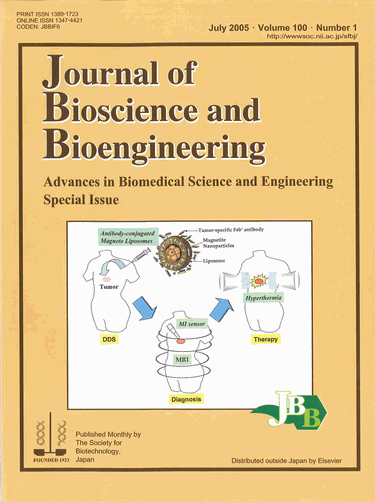
A therapeutic strategy using magnetic nanoparticles.
Tumor-specific Fab’ antibody-conjugated magnetoliposomes accumulate in the tumor tissues via the drug delivery system (DDS). Magnetite nanoparticles can be used for cancer diagnosis by magnetic resonance imaging (MRI) or for a magnetoimpedance (MI) sensor. Hyperthermia can then be induced by an alternating magnetic field (AMF) exposure. Thus, functionalized magnetite nanoparticles can offer a powerful tool for cancer therapy as well as diagnosis.
Related article: Ito, A., Shinkai, M., Honda, H., and Kobayashi, T., “Medical application of functionalized magnetic nanoparticles“, J. Biosci. Bioeng., vol. 1001-11 (2005).
⇒JBBアーカイブ:Vol.107 (2009) ~最新号
⇒JBBアーカイブ:Vol. 93(2002)~Vol. 106(2008)
Journal of Bioscience and Bioengineering
Published by 学会事務局 on 28 1月 2011
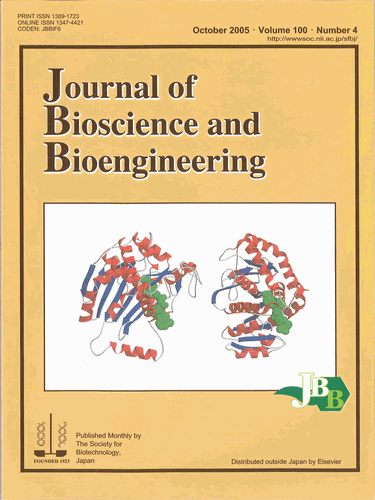
Finding of a new family of NAD(P)H-dependent oxidoreductases with no Rossmann-fold.
The Overall structure of Δ1-piperideine-2-carboxylate (Pip2C)/Δ1-pyrroline-2-carboxylate (Pyr2C) reductase from Pseudomonas syringae (left) is distinct from that of a typical Rossmann-fold enzyme, malate dehydrogenase from Escherichia coli (right). α-Helices and α-sheets are shown in red and blue, respectively. NADP+ (left) and NAD+ (right) molecules are in green.
The new NAD(P)H-dependent oxidoreductase family proteins which have no Rossmann-fold were classified into eight clades. Pip2C/Pyr2C reductase belongs to the DpkA clade in the new family. This classification would be useful for reliable functional annotation of the new family of NAD(P)H-dependent oxidoreductases.
Related article: Muramatsu, H., Mihara, H., Goto, M., Miyahara, I., Hirotsu, K., Kurihara, T., and Esaki, N., “A new family of NAD(P)H-dependent oxidoreductases distinct from conventional Rossmann-fold proteins“, J. Biosci. Bioeng., vol. 99, 541-547 (2005).
⇒JBBアーカイブ:Vol.107 (2009) ~最新号
⇒JBBアーカイブ:Vol. 93(2002)~Vol. 106(2008)
Journal of Bioscience and Bioengineering
Published by 学会事務局 on 28 1月 2011
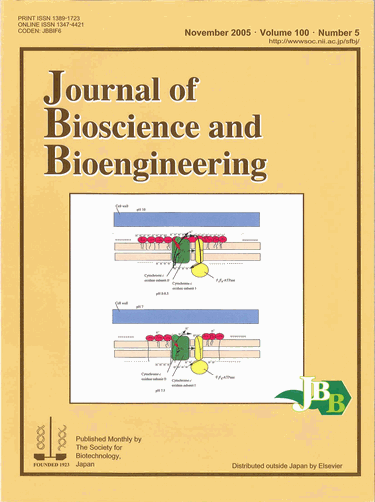
Terminal oxidation models postulated in alkaliphilic (upper) and neutralophilic (lower) bacilli.
Some alkaliphilic bacilli produce much cytochrome c responsible for their growth at high pHs. Based on the difference in the midpoint redox potential between cytochrome c and cytochrome a in alkaliphiles in contrast to neutralophiles, H+-coupled electron transfer of cytochrome c is probably demonstrated to play a crucial role in the adaptation of alkaliphiles at high pHs.
Related article: Goto, T., Matsuno, T., Hishinuma-Narisawa, M., Yamazaki, K., Matsuyama, H., Inoue, N., and Yumoto, I., “Cytochrome c and Bioenergetic Hypothetical Model for Alkaliphilic Bacillus spp.“, J. Biosci. Bioeng., vol. 100, 365-379 (2005).
⇒JBBアーカイブ:Vol.107 (2009) ~最新号
⇒JBBアーカイブ:Vol. 93(2002)~Vol. 106(2008)
Journal of Bioscience and Bioengineering
Published by 学会事務局 on 28 1月 2011
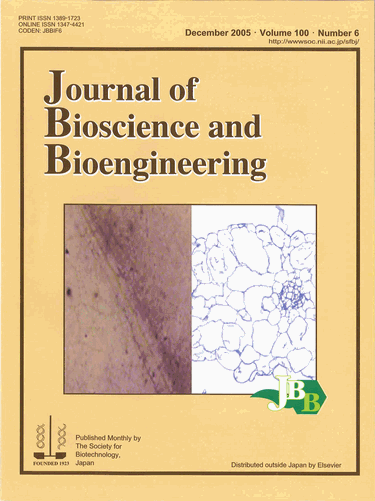
Immunocytochemical detection of poly-γ-glutamate (γPGA) expressed in tobacco leaf tissues.
Left panel, Whole mount staining of leaf containing parts transformed with control vector (left) or a mixture of pgsA, pgsB, and pgsC Agrobacterium strains (right) separated by a vein. Right panel, Cross-section of leaf (4 μm thick) transformed with a mixture of pgsA, pgsB, and pgsC Agrobacterium strains.
The pgsA, pgsB, and pgsC form the γPGA synthetase system (pgs) complex. These immunocytochemical results indicate that the pgs complex expressed transiently in tobacco tissues could produce sufficient γPGA.
Related article: Tarui, Y., Iida, H., Ono, E., Miki, W., Hirasawa, E., Fujita, K., Tanaka, T., and Taniguchi, M., “Biosynthesis of poly-γ-glutamic acid in plants: transient expression of poly-γ-glutamate synthetase complex in tobacco leaves“, J. Biosci. Bioeng., vol. 100, 443-448 (2005).
⇒JBBアーカイブ:Vol.107 (2009) ~最新号
⇒JBBアーカイブ:Vol. 93(2002)~Vol. 106(2008)
Journal of Bioscience and Bioengineering
Published by 学会事務局 on 28 1月 2011
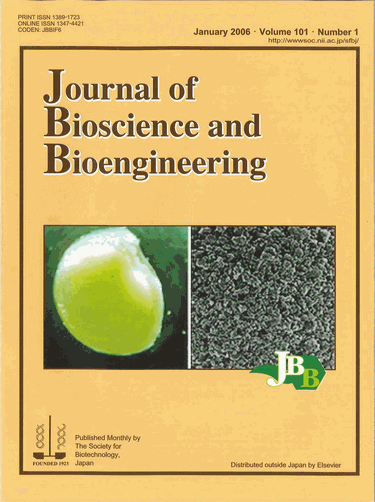
RGD43 hydrogel scaffold overview (left) and scanning electron microscopic observation of the RGD43 hydrogel scaffold (right).
RGD43 is recombinant artificial extracellular matrix protein with 43 repeats of Arg-Gly-Asp (RGD) sequence. RGD43 hydrogel scaffold was prepared by cross-linking the RGD43 using glutaraldehyde. NIH3T3 cells adhered on the RGD43 hydrogel surface. The adherent cells extended filopodia and spread on the hydrogel. Thus the RGD43 hydrogel scaffold might be suitable for use as a biodegradable scaffold for tissue engineering.
Related article: Kurihara, H. and Nagamune, T., “Cell adhesion ability of artificial extracellular matrix proteins containing a long repetitive Arg-Gly-Asp sequence“, J. Biosci. Bioeng., vol.100, 82-87 (2005).
⇒JBBアーカイブ:Vol.107 (2009) ~最新号
⇒JBBアーカイブ:Vol. 93(2002)~Vol. 106(2008)
Journal of Bioscience and Bioengineering
Published by 学会事務局 on 28 1月 2011
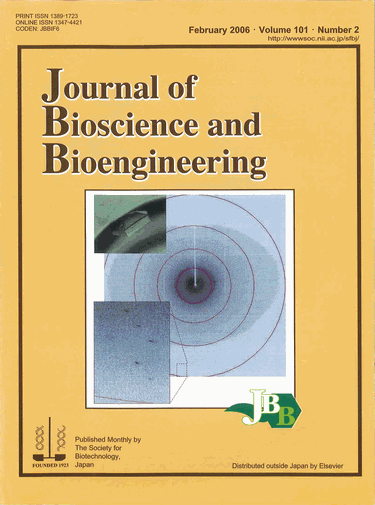
Crystallization of human triosephosphate isomerase.
Left-upper panel, Crystal of human triosephosphate isomerase from the microstirring technique at a rotation speed of 75 rpm. Stirring the protein solution prevents excess spontaneous nucleation and accelerates the growth of protein crystals, resulting in production of large and high-quality crystals. Large and left-lower panels, X-ray diffraction patterns of human triosephosphate isomerase crystal grown by the microstirring technique.
The outermost circle represents 1.2 Å resolution. The crystals showed diffraction maximally at a resolution of 1.2 Å and the data were processed at 1.41 Å resolution.
Related article: Adachi, H., Niino, A., Kinoshita, T., Warizaya, M., Maruki, R., Takano, K., Matsumura, H., Inoue, T., Murakami, S., Mori, Y., and Sasaki, T., “Solution-stirring method improves crystal quality of human triosephosphate isomerase“, J. Biosci. Bioeng., vol.101, 83-86 (2006).
⇒JBBアーカイブ:Vol.107 (2009) ~最新号
⇒JBBアーカイブ:Vol. 93(2002)~Vol. 106(2008)
Journal of Bioscience and Bioengineering
Published by 学会事務局 on 28 1月 2011
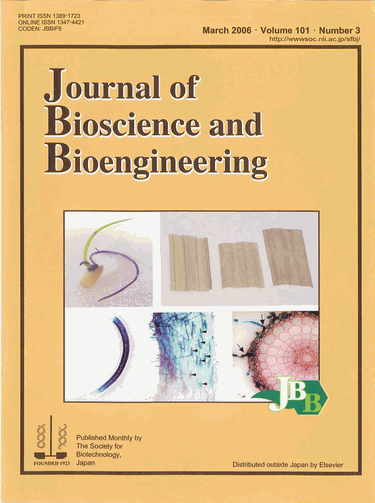
Arabidopsis PHT1 promoter available for root-specific expression of heterologous genes in dicots and monocots.
The promoter of PHT1 encoding phosphate transporter of Arabidopsis thaliana was fused to β-glucuronidase (GUS) gene and the construct (PHT1 promoter::GUS) was introduced into Arabidopsis and rice. Histochemical localization of GUS activity of a T1 rice plant indicated that plantlet exhibits strong GUS activity in roots (above left), GUS signal is not found in the leaves (above right), strong GUS signal is observed in the roots except for root tip (below left), GUS signaling is stronger in cells that generate root hairs than in cells that do not (below middle), and that root hair cells show strong GUS activity (transverse section).
The results obtained indicated that the dicot promoter can function efficiently in monocot plants, and that the PHT1 promoter is a practical promoter for root-specific expression of heterologous genes both in dicots and monocots.
Related article: Koyama, T., Ono, T., Shimizu, M., Jinbo, T., Mizuno, R., Tomita, K., Mitsukawa, N., Kawazu, T., Kimura, T., Ohmiya, K., and Sakka, K., “Promoter of Arabidopsis thaliana phosphate transporter gene drives root-specific expression of transgene in rice“, J. Biosci. Bioeng., vol.99, 38-42 (2005).
⇒JBBアーカイブ:Vol.107 (2009) ~最新号
⇒JBBアーカイブ:Vol. 93(2002)~Vol. 106(2008)
Journal of Bioscience and Bioengineering
Published by 学会事務局 on 28 1月 2011
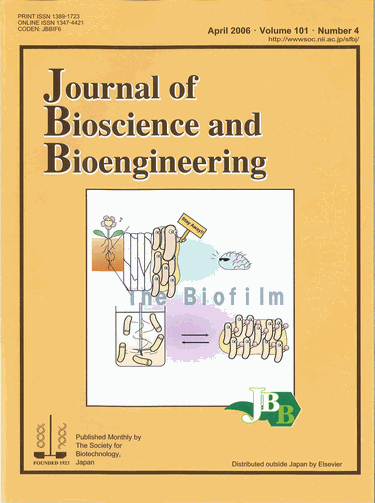
Beneficial biofilms have opened the way for the development of new biotechnology.
Biofilms are densely packed multicellular communities of microorganisms attached to a surface or interface. Bacteria can initiate biofilm formation in response to specific environmental conditions. Understanding the mechanism of biofilm formation is important for exploring effective strategies to control harmful biofilm formation, such as the one by pathogenic bacteria, and to promote beneficial biofilm formation. Regarding the latter case, the author indicates, by presenting scientific caricatures, that biofilms can function as a biocontrol agent to protect plants against infection by pathogenic bacteria (upper part), as a bioreactor for the production of various metabolites never attained by the cells under planktonic growth conditions (lower part), as an inhibitor of mild steel corrosion, and so on, thus suggesting the exploitation of beneficial bacterial biofilms may lead to a new biotechnology.
Related article: Morikawa, M., “Beneficial biofilm formation by industrial bacteria Bacillus subtilis and related species“, J. Biosci. Bioeng., vol.101, 1-8 (2006).
Illustration by Tojo, T.
⇒JBBアーカイブ:Vol.107 (2009) ~最新号
⇒JBBアーカイブ:Vol. 93(2002)~Vol. 106(2008)
Journal of Bioscience and Bioengineering
Published by 学会事務局 on 28 1月 2011

Binding sites of inorganic polyphosphate/ATP-glucomannokinase (GMK) for glucose (red), Pi-A (orange), and Pi-B (yellow) (left), and C-terminal half of human hexokinase I (C-HK I) for glucose (red) and ADP (orange) (right). Hydrogen bonds are indicated by dotted lines. In C-HK I, interactions of amino acid residues with the β-phosphoryl group are not indicated, since this group was not located at the proper site. These pictures suggest that Pi-A in GMK represents the binding site for phosphoryl group of ATP and inorganic polyphosphate.
Related article: Kawai, S., Mukai, T., Mori, S., Mikami, B., and Murata, K., “Hypothesis: structures, evolution, and ancestor of glucose kinases in the hexokinase family“, J. Biosci. Bioeng., vol.99, 320-330 (2005).
⇒JBBアーカイブ:Vol.107 (2009) ~最新号
⇒JBBアーカイブ:Vol. 93(2002)~Vol. 106(2008)
Journal of Bioscience and Bioengineering
Published by 学会事務局 on 28 1月 2011
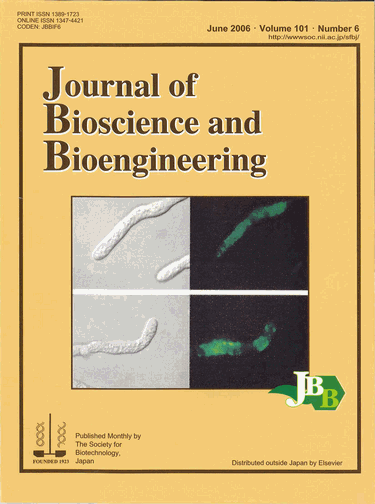
Membrane-bound lipase responsible for biodiesel-fuel production.
The use of immobilized fungal cells as whole-cell biocatalysts represents an attractive process for creating new application, particularly in the bulk production of commodity-type products such as biodiesel and polyesters. The immobilized fungus Rhizopus oryzae cells catalyze the methanolysis of plant oils, the products of which can be used as biodiesel fuel. Immobilized growing cells of R. oryzae produce two types of lipases, cell wall- and membrane-bound lipases, both of which are induced in the presence of olive oil or oleic acid.
The microscopy of immunofluorescence-labeled R. oryzae cells indicated that the green fluorescence of immunostained lipase was more clearly observed in the hyphal cell wall of cells cultivated with olive oil (below, right), when compared with that of cells cultured in the absence of the oil (above, right). Together with the biochemical analysis of lipase localization, the authors concluded that the membrane-bound lipase plays a crucial role in the methanolysis activity of the fungus cells.
Related article: Hama, S., Tamalampudi, S., Fukumizu, T., Miura, K., Yamaji, H., Kondo, A., and Fukuda, H., “Lipase localization in Rhizopus oryzae cells immobilized within biomass support particles for use as whole-cell biocatalysts in biodiesel-fuel production“, J. Biosci. Bioeng., vol. 101, 328-333 (2006).
⇒JBBアーカイブ:Vol.107 (2009) ~最新号
⇒JBBアーカイブ:Vol. 93(2002)~Vol. 106(2008)
Journal of Bioscience and Bioengineering
Published by 学会事務局 on 28 1月 2011
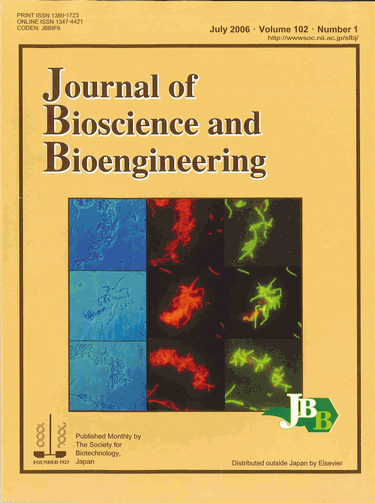
Novel probe useful for detection of Bacillus coagulans.
To produce L-lactic acid necessary for the production of poly-L-lactic acid plastic, kitchen refuse was inoculated with Bacillus coagulans under nonsterilized openculture conditions as a model system. At the temperature above around 50°C, the culture was shown to accumulate only L-lactic acid efficiently. The microflora in this type of culture is often disturbed by contaminated microorgansisms, and analysis of the microflora is, therefore, indispensably required to maintain the productivity of the acid.
The feasibility of 16S rRNA-targeted oligonucleotide probe for B. coagulans, Bcoa191, was examined by whole-cell fluorescence in situ hybridization (FISH) method. When the probe was applied to the culture of B. coagulans mixed with Lactobacillus plantarum (top panel), Lactobacillus rhamnosus (middle panel), and with Escherichia coli (bottom panel), the probe Bcoa191 specifically recognized B. coagulans, and differentiated the species from other bacteria (right column), although, as a matter of course, phase contrast microscopic (left column) and fluoro-microscopic observations using rhodamine-EUB338 (middle column) did not.
Related article: Sakai, K. and Ezaki, Y., “Open L-lactic acid fermentation of food refuse using thermophilic Bacillus coagulans and fluorescence in situ hybridization analysis of microflora“, J. Biosci. Bioeng., vol. 101, 457-463 (2006).
⇒JBBアーカイブ:Vol.107 (2009) ~最新号
⇒JBBアーカイブ:Vol. 93(2002)~Vol. 106(2008)
Journal of Bioscience and Bioengineering
Published by 学会事務局 on 28 1月 2011
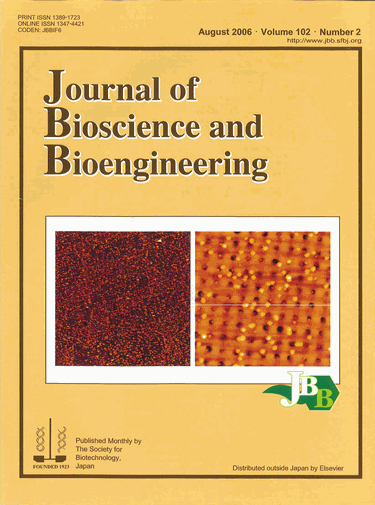
Tapping mode atomic force microscopy (AFM) topographic images of L3-liposome.
The AFM images of electron-beam-developed areas in the scales of 30 x 30 μm2 (left) and 5 x 5 μm2 (right). L3-liposome was prepared on the patterned substrate by electron-beam lithography technique. This method is greatly anticipated for biosensor application.
Related article: Jung, H. S., Kim, J. M., Park, J. W., Lee, S. E., Lee, H. Y., Kuboi, R., and Kawai, T., “Atomic force microscopy observation of highly arrayed phospholipid bilayer vesicle on a gold surface“, J. Biosci. Bioeng., vol. 102, 28-33 (2006).
⇒JBBアーカイブ:Vol.107 (2009) ~最新号
⇒JBBアーカイブ:Vol. 93(2002)~Vol. 106(2008)
Journal of Bioscience and Bioengineering
Published by 学会事務局 on 28 1月 2011
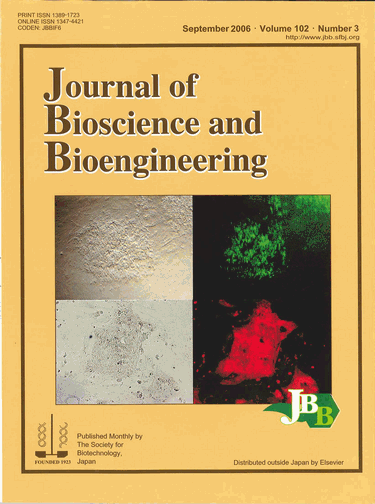
Observation of the cynomolgus monkey embryonic stem (cES) cell lines expressing GFP.
cES1 cells expressed fluorescent GFP (upper right) and showed high alkaline phosphatase activity (lower right). The same fields in bright field are shown in left. The cES cell lines are considered useful for basic research, including cell transplantation.
Related article: Ueda, S., Yoshikawa, M., Ouji, Y., Saito, K., Moriya, K., Nishiofuku, M., Hayashi, N., Ishizaka, S., Shimada, K., Konishi, N., and Fukui, H., “Cynomolgus monkey embryonic stem cell lines express green fluorescent protein“, J. Biosci. Bioeng., vol. 102, 14-20 (2006).
⇒JBBアーカイブ:Vol.107 (2009) ~最新号
⇒JBBアーカイブ:Vol. 93(2002)~Vol. 106(2008)
Journal of Bioscience and Bioengineering
Published by 学会事務局 on 28 1月 2011
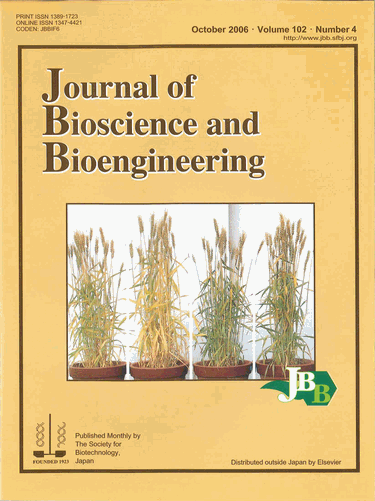
Simple and efficient wheat transformation method using Agrobacterium tumefaciens.
For the genetic transformation of plants, Agrobacterium mediated and microparticle bombardment methods have currently been used, of which the latter is more frequently employed by wheat investigators. However, the in planta transformation method recently developed by Supartana et al. took away some disadvantages of the conventional in vitro Agrobacterium mediated transformation method, which requires sterile conditions and time-consuming processes, in addition to the low transformation frequency and induction of mutation or somaclonal variation during in vitro cultures.
The in planta transformation method involves no in vitro culture of plant cells or tissues, which is the greatest advantage. This simple and efficient method was applied to the transformation of wheat, Triticum aestivum L. var. Shiranekomugi. The seeds were inoculated with three strains of A. tumefaciens, M-21 mutant strain (second left), the LBA4404 strain harboring a pBI-res binary vector (second right), and the LBA4404 strain harboring a pIG121-Hm binary vector (right), and grown to maturation in pots. The transformants thus obtained (To) showed the altered phenotypes, when compared with that of nontransformant (left), suggesting the great applicability of the in planta transformation method for the breeding of wheat.
Related article: Supartana, P., Shimizu, T., Nogawa, M., Shioiri, H., Nakajima, T., Haramoto, N., Nozue, M., and Kojima, M., “Development of simple and efficient in planta transformation method for wheat (Triticum aestivum L.) using Agrobacterium tumefaciens“, J. Biosci. Bioeng., vol. 102, 162-170 (2006).
⇒JBBアーカイブ:Vol.107 (2009) ~最新号
⇒JBBアーカイブ:Vol. 93(2002)~Vol. 106(2008)
Journal of Bioscience and Bioengineering
Published by 学会事務局 on 28 1月 2011
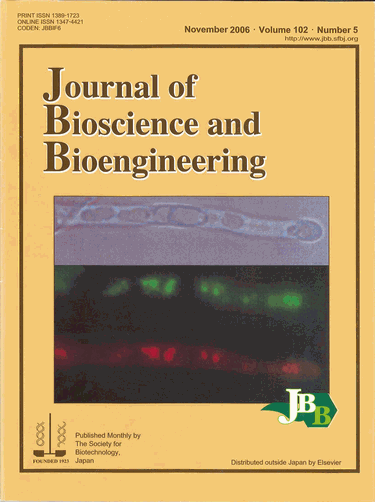
Localization of alternative oxidase in mitochondoria of citric acid-producing Aspergillus niger.
A filamentous fungus Aspergillus niger is industrially used for the production of citric acid. However, it remains unclear why citric acid is overproduced by A. niger. The cyanide-insensitive respiratory pathway, catalyzed by an alternative oxidase (AOX) has been shown to contribute to the production of a large amount of the acid. As the first step to analyze the mechanism underlying the overproduction of citric acid, a fusion gene, aox1-egfp, encoding AOX and enhanced green fluorescent protein (EGFP) were constructed and introduced into A. niger.
In A. niger transformant, the fusion protein AOX-EGFP was confirmed to occur in mitochondria through the comparison of the sites of the green fluorescence by AOX-EGFP (middle panel) with those of the red fluorescence stained with Mito Tracker Red CMXRos (bottom panel), suggesting the relation between citric acid production and AOX in A. niger.
Related article: Kirimura, K., Ogawa, S., Hattori, T., and Kino, K., “Expression analysis of alternative oxidase gene (aox1) with enhanced green fluorescent protein as marker in citric acid-producing Aspergillus niger“, J. Biosci. Bioeng., vol. 102, 210-214 (2006).
⇒JBBアーカイブ:Vol.107 (2009) ~最新号
⇒JBBアーカイブ:Vol. 93(2002)~Vol. 106(2008)
Journal of Bioscience and Bioengineering
Published by 学会事務局 on 28 1月 2011
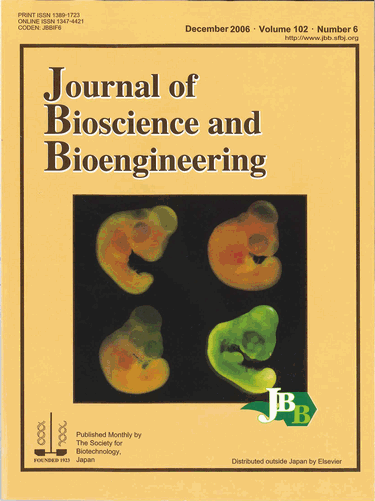
Transgenic avian as a transgenic bioreactor for production of recombinant proteins.
To generate genetically manipulated quails having ability to produce recombinant proteins, concentrated retroviral vector was injected into quail embryo. The figure shows the expression of LacZ in quail embryos to which viral vector carrying LacZ gene were injected at the following various incubation times; top left, 0 h; top right, 24 h; down left, 36 h; down right, 48 h. LacZ was expressed in the whole body of embryos injected at 48 h incubation (down right).
The anti-prion scFv-Fc gene was also expressed in serum and egg white of the injected quail embryos. This system exhibits the potential of transgenic quails for the commercial production of recombinant protein.
Related article: Kawabe, Y., Kamihira, M., Ono, K., Kyogoku, K., Nishijima, K., and Iijima, S., “Production of scFv-Fc fusion protein using genetically manipulated quails“, J. Biosci. Bioeng., vol. 102, 297-303 (2006).
⇒JBBアーカイブ:Vol.107 (2009) ~最新号
⇒JBBアーカイブ:Vol. 93(2002)~Vol. 106(2008)
Journal of Bioscience and Bioengineering
Published by 学会事務局 on 28 1月 2011
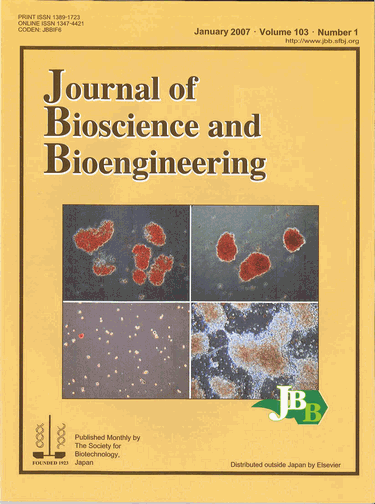
Effect of polymer surface properties on morphology, growth rate, and differentiation of mouse embryonic stem (ES) cells.
Alkaline phosphatase staining of mouse ES cells cultured on different photoimmobilized polymers: an anionic polymer (top, left), a cationic polymer (bottom, left), a zwitterionic polymer (top, right), and a biological polymer (bottom, right). The red color indicates the cells stained for alkaline phosphatase, a marker of the undifferentiated state of the cells. The polymer surface properties can affect the morphology, growth rate, and differentiation of mouse ES cells.
Related article: Konno, T., Kawazoe, N., Chen, G., and Ito, Y., “Culture of mouse embryonic stem cells on photoimmobilized polymers“, J. Biosci. Bioeng., vol. 102, 304-310 (2006).
⇒JBBアーカイブ:Vol.107 (2009) ~最新号
⇒JBBアーカイブ:Vol. 93(2002)~Vol. 106(2008)
Journal of Bioscience and Bioengineering
Published by 学会事務局 on 28 1月 2011
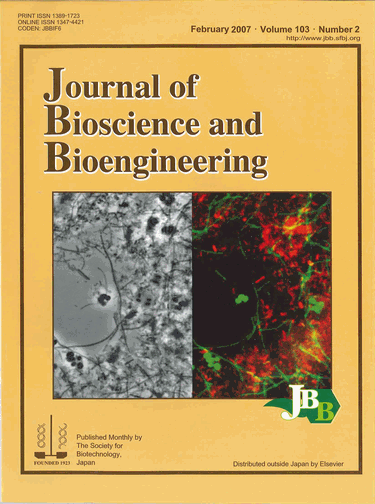
Fluorescence in situ hybridization (FISH) analysis of bacteria and archaea in chemostat.
Authors established a chemostat cultivation method for a mesophilic methanogenic consortium degrading long-chain fatty acids. Left panel shows a phase-contrast image of microorganisms in chemostat. Right panel shows bacteria (red) and archaea (green) visualized by FISH using archaeal- and bacterial-domain-specific probes. Authors detected the following major groups of methanogen within the archaeal community: the aceticlastic genera Methanosaeta and Methanosarcina and the hydrogenotrophic genus Methanospirillum.
Related article: Shigematsu, T., Tang, Y., Mizuno, Y., Kawaguchi, H., Morimura, S., and Kida, K., “Microbial diversity of mesophilic methanogenic consortium that can degrade long-chain fatty acids in chemostat cultivation“, J. Biosci. Bioeng., vol. 102, 535-544 (2006).
⇒JBBアーカイブ:Vol.107 (2009) ~最新号
⇒JBBアーカイブ:Vol. 93(2002)~Vol. 106(2008)
Journal of Bioscience and Bioengineering
Published by 学会事務局 on 28 1月 2011
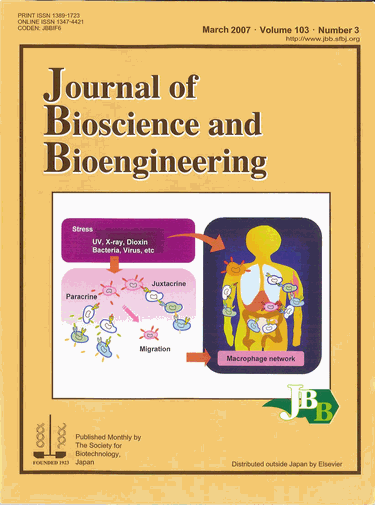
Macrophage network theory.
Information related to the external environment and stimuli could be transferred from local macrophages to other tissue macrophages. Authors hypothesized the existence of a network formed by tissue macrophages and termed this putative communication network a macrophage network. Based on this theory, lipopolysaccharide derived from Pantoea agglomerans can be applied to health care.
Related article: Kohchi, C., Inagawa, H., Nishizawa, T., Yamaguchi, T., Nagai, S., and Soma, G., “Applications of lipopolysaccharide derived from Pantoea agglomerans (IP-PA1) for health care based on macrophage network theory“, J. Biosci. Bioeng., vol. 102, 485-496 (2006).
⇒JBBアーカイブ:Vol.107 (2009) ~最新号
⇒JBBアーカイブ:Vol. 93(2002)~Vol. 106(2008)
Journal of Bioscience and Bioengineering
Published by 学会事務局 on 28 1月 2011
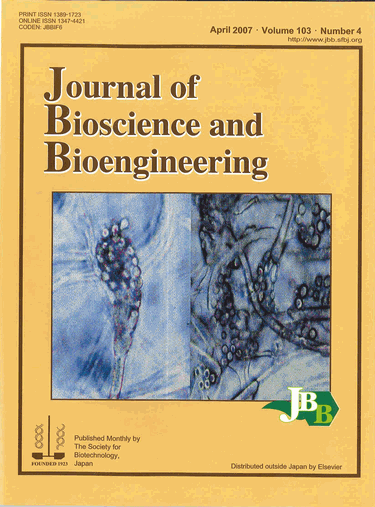
Conidia formation of Aspergillus oryzae in wheat bran powder medium.
A. oryzae was grown in wheat bran powder media at K2HPO4 concentrations of 0.02% (left) and 0.05% (right). As shown in these micrographs, an increase in the amount of phosphate resulted in more conidia. This increase is likely to be associated with the increased production of dye-decolorizing peroxidase, which can be applied to treat colored wastewater.
Related article: Shakeri, M., Sugano, Y., and Shoda, M., “Production of dye-decolorizing peroxidase (rDyP) from complex substrates by repeated-batch and fed-batch cultures of recombinant Aspergillus oryzae“, J. Biosci. Bioeng., vol. 103, 129-134 (2007).
⇒JBBアーカイブ:Vol.107 (2009) ~最新号
⇒JBBアーカイブ:Vol. 93(2002)~Vol. 106(2008)
Journal of Bioscience and Bioengineering
Published by 学会事務局 on 28 1月 2011
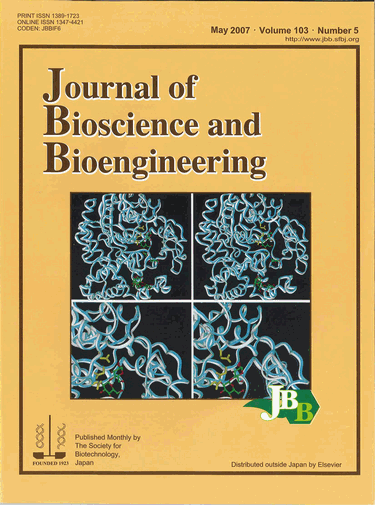
Superimposition of structures of amylomaltase.
The structure of Thermus aquaticus amylomaltase in native form (white) was superimposed on that in acarbose-complex form (blue). Upper panels show the overall structures and lower panels indicate the enlarged view of proposed accepter binding site. This superimposition revealed a conformational change around the acceptor binding site which is caused by the binding of substrate to the second substrate binding site 14Å away from catalytic residues.
Related article: Fujii, K., Minagawa, H., Terada, Y., Takaha, T., Kuriki, T., Shimada, J., and Kaneko, H., “Function of second glucan binding site including tyrosines 54 and 101 in Thermus aquaticus amylomaltase“, J. Biosci. Bioeng., vol. 103, 167-173 (2007).
⇒JBBアーカイブ:Vol.107 (2009) ~最新号
⇒JBBアーカイブ:Vol. 93(2002)~Vol. 106(2008)
Journal of Bioscience and Bioengineering
Published by 学会事務局 on 28 1月 2011
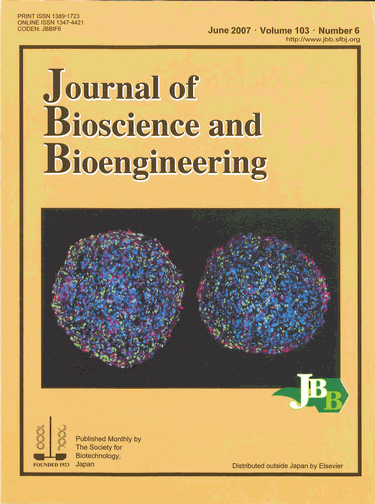
Typical fluorescence images of immunostained neurosphere sections.
The neurosphere sections were counterstained with TO-PRO-3 (blue) and immunostained with a proliferating cell marker (anti-BrdU antibody: green) and a glial cell marker (left-hand image: anti-GFAP antibody, red) or neuronal cell marker (right-hand image: anti-β III tubulin antibody, red). Image cytometry revealed new findings in terms of the localization of specific types of neural cells and the regional fluctuation of cell density in neurospheres.
Related article: Mori, H., Ninomiya, K., Kanemura, Y., Yamasaki, M., Kino-oka, M., and Taya, M., “Image cytometry for analyzing regional distribution of cells inside human neurospheres“, J. Biosci. Bioeng., vol. 103, 384-387 (2007).
⇒JBBアーカイブ:Vol.107 (2009) ~最新号
⇒JBBアーカイブ:Vol. 93(2002)~Vol. 106(2008)
Journal of Bioscience and Bioengineering
Published by 学会事務局 on 28 1月 2011
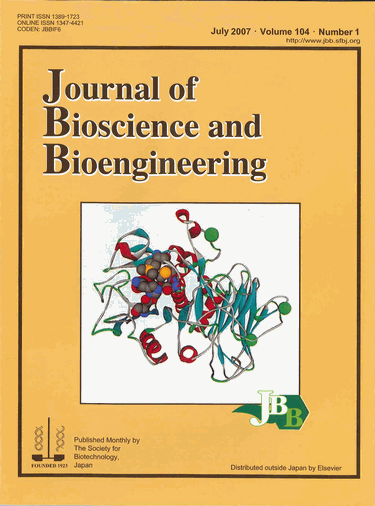
The crystal structure of a chemical oxidant-resistant alkaline phosphatase (KP-43).
α-helices and β-strands are shown as red and blue ribbons, respectively, while calcium ions are represented by green spheres. KP-43 has been produced on an industrial-scale and can be incorporated into laundry detergents. Although the detailed mechanism is still puzzling, a possible mechanism underlying the oxidative stability of KP-43 would be the slow oxidation of Met256 in the vicinity of the catalytic Ser255.
Related article: Saeki, K., Ozaki, K., Kobayashi, T., and Ito, S., “Detergent alkaline proteases: enzymatic properties, genes, and crystal structures“, J. Biosci. Bioeng., vol. 103, 501-508 (2007).
⇒JBBアーカイブ:Vol.107 (2009) ~最新号
⇒JBBアーカイブ:Vol. 93(2002)~Vol. 106(2008)
Journal of Bioscience and Bioengineering
Published by 学会事務局 on 28 1月 2011
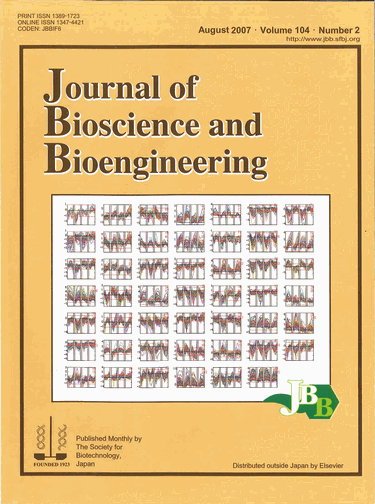
Comparison of gene expression patterns between 0.75 M NaCl and 1 M sorbitol additions in laboratory and brewing strains of yeast using clustering analysis.
Each graph indicates the gene expression patterns of genes in its cluster. The first and second curves in each graph represent the gene expression patterns of the laboratory and brewing strains, respectively, under 0.75 M NaCl addition condition, and the third and forth curves represent those of the laboratory and brewing strains under 1 M sorbitol addition condition. The horizontal axis indicates the time points of the data, and vertical axis indicates the log (base 2) expression ratio. The three horizontal lines represent twofold expression level changes (log22=1 and log21/2=-1) and no change (log21=0). The upper and lower numbers on the right side of each graph represent the cluster number and the number of the genes included in the corresponding cluster, respectively.
Related article: Hirasawa, T., Ashitani, K., Yoshikawa, K., Nagahisa, K., Furusawa, C., Katakura, Y., Shimizu, H., and Shioya, S., “Comparison of transcriptional responses to osmotic stresses induced by NaCl and sorbitol additions in Saccharomyces cerevisiae using DNA microarray“, J. Biosci. Bioeng., vol. 102, 568-571 (2006).
⇒JBBアーカイブ:Vol.107 (2009) ~最新号
⇒JBBアーカイブ:Vol. 93(2002)~Vol. 106(2008)
Journal of Bioscience and Bioengineering
Published by 学会事務局 on 28 1月 2011
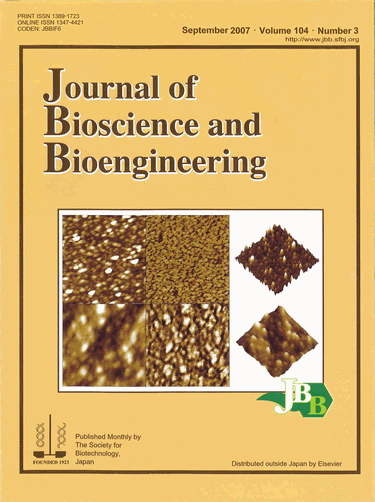
Atomic force microscope (AFM) images of unmodified and RGDS modified chitosan membranes.
The phase images viewed side-by-side on the left hand side provide information about the surface structure. Three-dimensional data are obtained from the height images on the right hand side.
Related article: Karakecili, A. G., Demirtas, T. T., Satriano, C., Gümüsderelioglu, M., and Marletta, G. J.,”Evaluation of L929 fibroblast attachment and proliferation on Arg-Gly-Asp-Ser (RGDS)-immobilized chitosan in serum-containing/serum-free cultures“, J. Biosci. Bioeng., vol. 104, 69-77 (2007).
⇒JBBアーカイブ:Vol.107 (2009) ~最新号
⇒JBBアーカイブ:Vol. 93(2002)~Vol. 106(2008)
Journal of Bioscience and Bioengineering
Published by 学会事務局 on 28 1月 2011
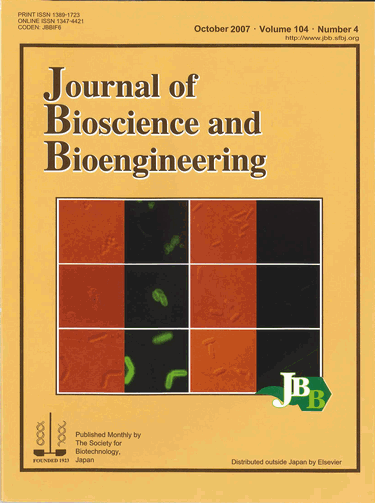
Cell wall-binding (CWB) domain of Staphylococcus aureus autolysin is used as an affinity reagent for bacteria.
Fluorescence image of CWB-GFP (green-fluorescent protein) fusion that binds to gram-positive bacteria is shown in this cover page. Growing bacteria are mixed with purified CWB-GFP and then observed with a fluorescence microscope. S. aureus, Corynebacterium glutamicum, Bacillus subtilis, Escherichia coli, Agrobacterium tumefaciens, and Pseudomonas aeruginosa were used (from top left to bottom right). Phase-contrast (left) and GFP (right) images are shown. CWB-GFP bound to a wide range of gram-positive bacteria, but not to most gram-negative bacteria.
Related article: Ahmed, A. B. F., Noguchi, K., Asami, Y., Nomura, K., Fujii, H., Sakata, M., Tokita, A., Noda, K., and Kuroda, A., “Evaluation of cell wall binding domain of Staphylococcus aureus autolysin as affinity reagent for bacteria and its application to bacterial detection”, J. Biosci. Bioeng., vol. 104, 55-61 (2007).
⇒JBBアーカイブ:Vol.107 (2009) ~最新号
⇒JBBアーカイブ:Vol. 93(2002)~Vol. 106(2008)
Journal of Bioscience and Bioengineering
Published by 学会事務局 on 28 1月 2011
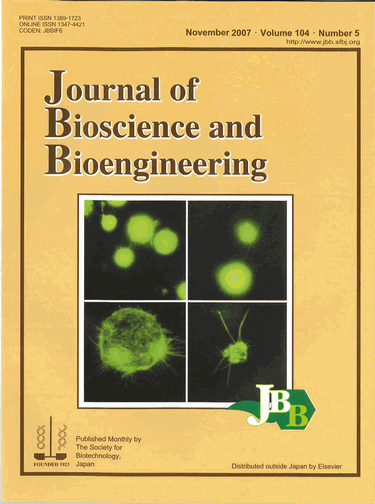
Fluorescence images of typical mini podia and long podia on mouse neural stem cells (NSCs) with staining of cytoplasm (upper images) and F-actin (lower images). NSCs were found to possess the protrusions of various lengths emerging from the cell body.
Related article: Mori, H., Fujitani, T., Kanemura, Y., Kino-oka, M., and Taya, M.,“Observational examination of aggregation and migration during early phase of neurosphere culture of mouse neural stem cells”, J. Biosci. Bioeng., vol. 104, 231-234 (2007).
⇒JBBアーカイブ:Vol.107 (2009) ~最新号
⇒JBBアーカイブ:Vol. 93(2002)~Vol. 106(2008)
Journal of Bioscience and Bioengineering
Published by 学会事務局 on 28 1月 2011
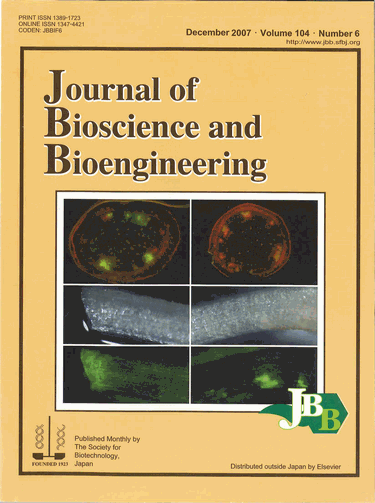
In planta monitoring of phytopathogenic Ralstonia solanacearum cells.
Bacterial cells tagged with GFP-expressing plasmid pRSS12 are visualized by strong green fluorescence emission. They accumulate in the stem xylem vessels (upper left panel), penetrate into the root tissues via xylem vessels (lower left panel) and form aggregates on the root surface (lower right panel) of tomato plants.
Related article: Kawasaki, T., Satsuma, H., Fujie, M., Usami, S., and Yamada, T., “Monitoring of phytopathogenic Ralstonia solanacearum cells using green fluorescent protein-expressing plasmid derived from bacteriophage φRSS1”, J. Biosci. Bioeng., vol. 104, 451-456 (2007).
⇒JBBアーカイブ:Vol.107 (2009) ~最新号
⇒JBBアーカイブ:Vol. 93(2002)~Vol. 106(2008)
Journal of Bioscience and Bioengineering
Published by 学会事務局 on 28 1月 2011
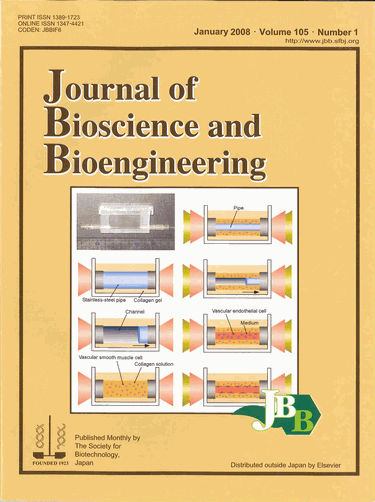
Schematic drawings of the fabrication of a double-layered tubular construct composed of vascular endothelial cells and smooth muscle cells.
The bioengineering-based technique enabled the fabrication of tubular constructs consistent with the makeup of native blood vessels, increasing the potential of our system for manufacturing whole organs and ultimately connecting up with the host vasculature.
Related article: Takei, T., Yamaguchi, S., Sakai, S., Ijima, H., and Kawakami, K.,“Novel technique for fabricating double-layered tubular constructs consisting of two vascular cell types in collagen gels used as templates for three-dimensional tissues”, J. Biosci. Bioeng., vol. 104, 435-438 (2007).
⇒JBBアーカイブ:Vol.107 (2009) ~最新号
⇒JBBアーカイブ:Vol. 93(2002)~Vol. 106(2008)
Journal of Bioscience and Bioengineering
Published by 学会事務局 on 28 1月 2011
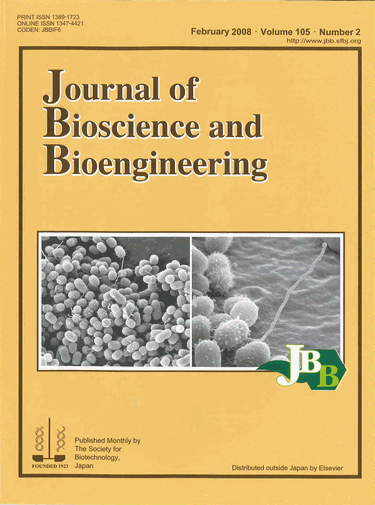
Extending and growing bacterial cell appendages on a highly adhesive bacterium, Acinetobacter sp. Tol 5.
This bacterium has at least two kinds of cell appendages, which are responsible for high adhesiveness of this bacterial cell. The bacterial cells have a small number (typically one) of anchor for a long distance interaction of several hundred nanometers with surfaces. They also have many peritrichate fibrils for a short distance interaction of several to several ten nanometers. These bacterial adhesive nanofibers are produced from a carbon source in the presence of surface areas sufficient for cell adhesion. We can see the peritrichate fibrils just sprouting and the anchors growing to longer than 3 μm on the photomicrographs.
Related article: Ishii, S., Miyata, S., Hotta, Y., Yamamoto, K., Unno, H., and Hori, K., Ishii, S., Miyata, S., Hotta, Y., Yamamoto, K., Unno, H., and Hori, K., “Formation of filamentous appendages by Acinetobacter sp. Tol 5 for adhering to solid surfaces”, J. Biosci. Bioeng., vol. 105, 20-25 (2008).
⇒JBBアーカイブ:Vol.107 (2009) ~最新号
⇒JBBアーカイブ:Vol. 93(2002)~Vol. 106(2008)
Journal of Bioscience and Bioengineering
Published by 学会事務局 on 28 1月 2011

New transgenic techniques using bioactive beads that have entrapped the DNA-lipofectin complex have been developed for introducing exogenous genes.The green fluorescence protein-expressing tobacco BY-2 protoplasts (left, phase contrast images; right, fluorescence images) resulted in fourfold higher transformation efficiency than that by the conventional method.
Related article: Murakawa, T., Kajiyama, S., Ikeuchi, T., Kawakami, S., and Fukui, K., “Improvement of transformation efficiency by bioactive-beads-mediated gene transfer using DNA-lipofectin complex as entrapped genetic material”, J. Biosci. Bioeng., vol. 105, 77-80 (2008).
⇒JBBアーカイブ:Vol.107 (2009) ~最新号
⇒JBBアーカイブ:Vol. 93(2002)~Vol. 106(2008)
Journal of Bioscience and Bioengineering
Published by 学会事務局 on 28 1月 2011
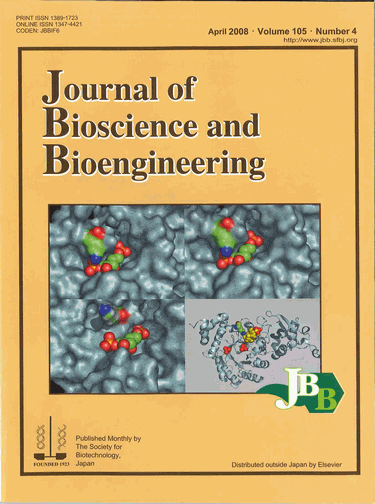
Comparison of the surface structure of RuBisCO surrounding the bound xylulose bisphosphate.
Homology model of vulcanus RuBisCO was constructed by MOE homology modeling tool using the crystal structure of 6301 RuBisCO with xylulose bisphosphate as the template. And the model of the vulcanus RuBisCO was refined by amber8. Tobacco RuBisCO with three Pi (PDB code 1EJ7) was bound with etidronate virtually by ASEDock in MOE.
Red and green spheres show oxygen and carbon atoms, respectively. Blue surface shows nitrogen of 326K. Yellow spheres show a cluster of 8 etidronates with highest binding energy calculated by ASEDock. Binding positions of xylulose bisphosphate against model were determined by superimposing the models on the crystal structure of 6301 RuBisCO with the ligand.
Related article: Iwaki, T., Shiota, K., Al-Taweel, K., Kobayashi, D., Kobayashi, A., Suzuki, K., Yui, T., and Wadano, A., “Inhibition of RuBisCO cloned from Thermosynechococcus vulcanus and expressed in Escherichia coli with compounds predicted by molecular operation environment (MOE)”, J. Biosci. Bioeng., vol. 105, 26-33 (2008).
⇒JBBアーカイブ:Vol.107 (2009) ~最新号
⇒JBBアーカイブ:Vol. 93(2002)~Vol. 106(2008)
Journal of Bioscience and Bioengineering
Published by 学会事務局 on 28 1月 2011
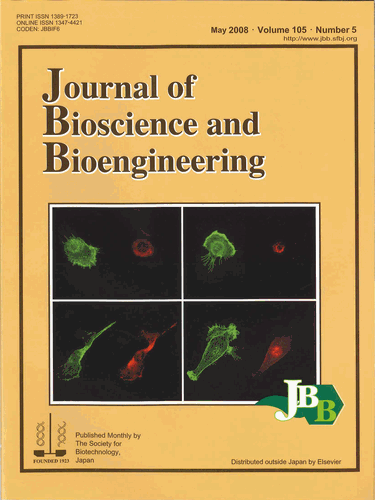
Fluorescent images showing organization of actin cytoskeleton (green) and glucose transporters, GLUTs, 1 and 4 (red) of human epithelial cells cultured on the surfaces with 0% (upper images) and 100% D-glucose (lower images) display.
The cells on the 100% D-glucose-displayed surface exhibited a stretched shape with a nebulous distribution of GLUTs1 and 4 expressions (lower, left and right images, respectively) in the entire cell body including the tip of the filopodia, whereas the cell on the 0% D-glucose-displayed surface showed extensive GLUT4 spots only on the cell body (upper, right image). It can be stated that the morphological changes of epithelial cells mainly depends on GLUT mediation on the D-glucose-displayed surfaces.
Related article: Kim, M.-H., Kino-oka, M., Kawase, M., Yagi, K., and Taya, M., “Glucose transporter mediation responsible for morphological changes of human epithelial cells on glucose-displayed surfaces”, J. Biosci. Bioeng., vol. 105, 319-326 (2008).
⇒JBBアーカイブ:Vol.107 (2009) ~最新号
⇒JBBアーカイブ:Vol. 93(2002)~Vol. 106(2008)
Journal of Bioscience and Bioengineering
Published by 学会事務局 on 28 1月 2011
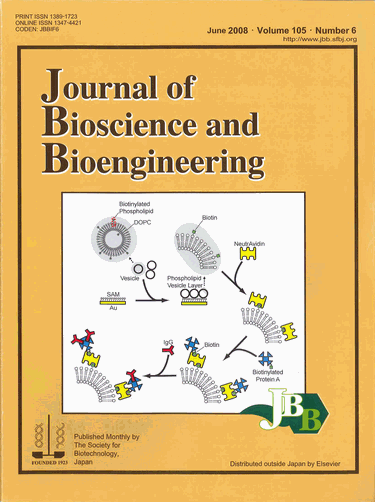
A biotin-containing phospholipid vesicle layer is used for surface resonance plasmon (SPR) biosensing.
When a suspension of vesicle composed of 1,2-dioleoyl-sn-glycero-3-phosphocholine (DOPC) and a biotinylated phospholipid is applied on a self-assembled monolayer (SAM) deposited on a gold-coated SPR sensor chip, the layer of the phospholipid vesicle (phospholipid vesicle layer) forms on the surface.
The vesicle layer can immobilize a biotinylated protein A through the biotin-avidin-biotin linkage. Furthermore, immunoglobulin G (IgG) can bind to the protein A immobilized on the vesicle layer. Because these reactions are designed to take place on the gold surface, the protein immobilization based on the biotin-containing phospholipid vesicle layer is a useful technique for SPR biosensing.
Related article: Ishizuka-Katsura, Y., Wazawa, T., Ban, T., Morigaki, K., and Aoyama, S. J., “Biotin-containing phospholipid vesicle layer formed on self-assembled monolayer of a saccharide-terminated alkyl disulfide for surface plasmon resonance biosensing”, J. Biosci. Bioeng., vol. 105, 527-535 (2008).
⇒JBBアーカイブ:Vol.107 (2009) ~最新号
⇒JBBアーカイブ:Vol. 93(2002)~Vol. 106(2008)
Journal of Bioscience and Bioengineering
Published by 学会事務局 on 28 1月 2011
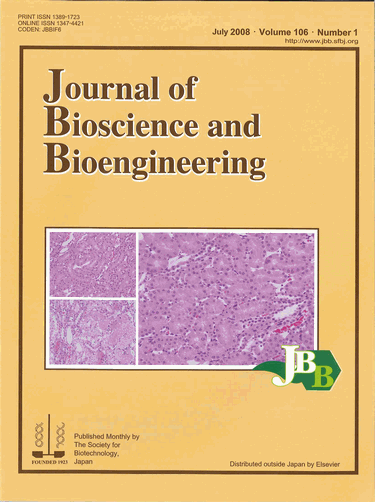
Activated neutrophils infiltrating into tissue release a variety of inflammatory cytokines and reactive oxygen species, leading to tissue injury.
Activated neutrophils are implicated in the development of ischemia/reperfusion (I/R)-induced renal failure. JTE-607, an N-benzoyl-L-phenylalanine-derived compound, is a multi-cytokine inhibitor that strongly suppresses the production of proinflammatory cytokines. JTE-607 reduced renal dysfunction and histopathologic changes in the kidneys of rats subjected to renal I/R by inhibiting neutrophil activation.
Figures are shown for rats in the sham group (upper left), rats treated with I/R plus saline (lower left), and rats treated JTE-607 prior to I/R (right).
Related article: Asaga, T., Ueki, M., Chujo, K., and Taie, S. J., “JTE-607, an inflammatory cytokine synthesis inhibitor, attenuates ischemia/reperfusion-induced renal injury by reducing neutrophil activation in rats“, J. Biosci. Bioeng., vol. 106, 22-26 (2008).
⇒JBBアーカイブ:Vol.107 (2009) ~最新号
⇒JBBアーカイブ:Vol. 93(2002)~Vol. 106(2008)
Journal of Bioscience and Bioengineering
Published by 学会事務局 on 28 1月 2011
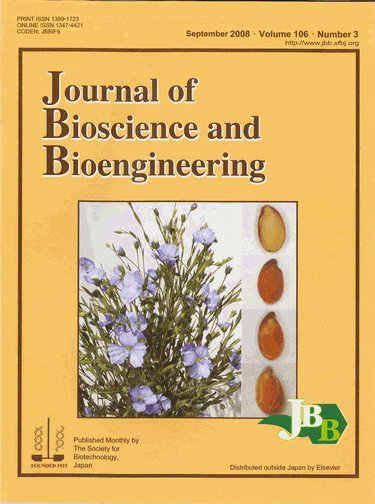
Enrichment of carotenoids in flaxseed.
Left: an untransformed flax plant (WARD cultivar). The transgenic flax plants were the same to untransformed control plants in their appearance except for seed color.
Right top: section of an untransformed flaxseed.
Right below three: sections of transgenic flaxseeds. These transgenic plants were generated by introduction of the phytoene synthase gene (crtB) derived from soil bacterium Pantoea ananatis (formerly called Erwinia uredovora 20D3).
The inner color of the transgenic flaxseeds was altered into orange due to the accumulation of β-carotene and α-carotene. Total carotenoid amounts in these seeds were 65.4-156.3 μg/g fresh weight, which corresponded to 7.8- to 18.6-fold increase, compared with those of untransformed controls.
Related article: Fujisawa, M., Watanabe, M., Choi, S.-K., Teramoto, M., Ohyama, K., and Misawa, N., “Enrichment of carotenoids in flaxseed (Linum usitatissimum) by metabolic engineering with introduction of bacterial phytoene synthase gene crtB” J. Biosci. Bioeng., vol. 105, 636-641 (2008).
⇒JBBアーカイブ:Vol.107 (2009) ~最新号
⇒JBBアーカイブ:Vol. 93(2002)~Vol. 106(2008)
Journal of Bioscience and Bioengineering
Published by 学会事務局 on 28 1月 2011
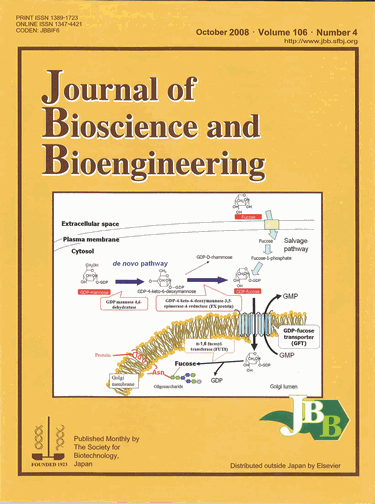
Glycosylation is the most extensive of all post-translational modifications and plays an important role in secretion, antigenicity, in vivo function, and the clearance of glycoproteins in blood. Glycosylation control is an important issue for the industrial production of therapeutic proteins. Human antithrombin III (AT-III) is a plasma glycoprotein and is used as a biopharmaceutical for preventing and regulating blood coagulation. The α-1,6 fucosylation of AT-III, which has four N-asparagine glycosylation sites, significantly reduces antithrombin–heparin affinity. Hence, defucosylation is one of the most important issues for quality control of commercial AT-III production using mammalian cell culture.
Figure illustrates the biosynthesis of GDP-fucose and protein fucosylation in a mammalian cell. Cytosol GDP-mannose is converted to GDP-4-keto-6-deoxymannose by GDP-mannose dehydratase (GMD). This intermediate is converted to GDP-fucose by GDP-4-keto-6-deoxymannnose-3,5-epimerase-4-reductase (GMER). GDP-fucose is transported through Golgi membrane by GDP-fucose transporter (GFT). In the Golgi apparatus, fucose is transferred from GDP-fucose to N-linked-type complex glycoprotein by α-1,6 fucosyltransferase (FUT8).
Related article: Omasa, T., Tanaka, R., Doi, T., Ando, M., Kitamoto, Y., Honda, K., Kishimoto, M., and Ohtake, H., “Decrease in antithrombin III fucosylation by expressing GDP-fucose transporter siRNA in Chinese hamster ovary cells“, J. Biosci. Bioeng., vol. 106, 168-173 (2008).
⇒JBBアーカイブ:Vol.107 (2009) ~最新号
⇒JBBアーカイブ:Vol. 93(2002)~Vol. 106(2008)
Journal of Bioscience and Bioengineering
Published by 学会事務局 on 28 1月 2011
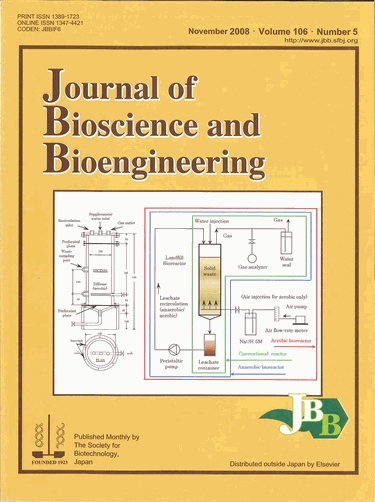
Microbial population dynamics and performance in lab-scale conventional, anaerobic, and aerobic landfill bioreactors specialized for high-organic wastes were investigated. Three acrylic cylindrical bioreactors of 10 cm diameter, 30 cm height, and 2.85 l in total volume were constructed as shown in the figure.
The configuration of these reactors includes three separate ports on the top for the addition of water, leachate recirculation, and gas measurement. The perforated plates on the top and at the bottom are used respectively for distributing liquid to the solid waste and for draining leachate into the container. Each reactor (2.35 l) was loaded with 1.5 kg of organic solid waste made of sludge cake, dry dog food, and wood chips.
The conventional reactor was operated without leachate recirculation and aeration, but the other reactors used leachate recirculation at 200 ml/d and without aeration (anaerobic bioreactor) or with aeration at 2 l/min (aerobic bioreactor).
Related article: Sang, N. N., Soda, S., Sei, K., and Ike, M., “Effect of aeration on stabilization of organic solid waste and microbial population dynamics in lab-scale landfill bioreactors“, J. Biosci. Bioeng., vol. 106, 425-432 (2008).
⇒JBBアーカイブ:Vol.107 (2009) ~最新号
⇒JBBアーカイブ:Vol. 93(2002)~Vol. 106(2008)
Journal of Bioscience and Bioengineering
Published by 学会事務局 on 28 1月 2011

Optimization of the timing for effective gene transduction into the chicken gonads.
To determine the best timing of viral injection for the expression and transduction of a transgene in the gonads, a viral solution was injected into chicken embryos at various stages of development after incubation for 50–60 h (stages 14–17).
The left panel shows embryonic developmental stage at the time of viral injection which was determined by microscopically assessing their size and shape; upper left, stage 14; upper right, stage 15; lower left, stage 16; lower right, stage 17.
The right panel shows the expression of LacZ in gonads isolated from manipulated embryos (just before hatching) after injecting a retroviral vector carrying LacZ gene at stage 15; upper, testis (L); middle, testis (R); lower, ovary.
Related article: Kawabe, Y., Naka, T., Komatsu, H., Nishijima, K., Iijima, S., and Kamihira, M., “Retroviral gene transduction into chicken embryo gonads through blood circulation”, J. Biosci. Bioeng., vol. 106, 598–601 (2008).
⇒JBBアーカイブ:Vol.107 (2009) ~最新号
⇒JBBアーカイブ:Vol. 93(2002)~Vol. 106(2008)
Journal of Bioscience and Bioengineering
Published by 学会事務局 on 28 1月 2011
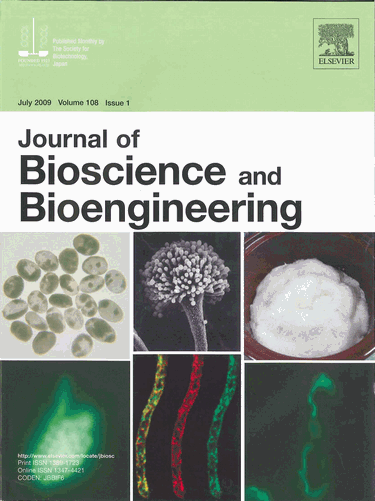
Sake is the Japanese traditional alcohol beverage. Two microbes, Aspergillus oryzae and Saccharomyces cerevisae, are utilized for brewing of sake from steamed rice.
Upper-left: Scanning electron micrograph of a conidial head in A. oryzae.
Upper-middle: Photograph of koji (steamed rice cultivated with A. oryzae). The photo of koji was kindly provided by Saga Prefectural Sake Brewers Guild.
Upper-right: Photograph of sake mash into which koji, steamed rice and S. cerevisiae are added.
Researches on the role of organelles of these microbes in sake brewing is now providing novel and critical insights into the technologies of sake brewing, and of general fermentation industries. Two fluorescent figures are representatives of these researches.
Lower-left: Dynamic morphology of Endoplasmic reticulum (ER) in A. oryzae. Fluorescent images show the ER morphologies at two time points (0 s and 30 s represented in green and red, respectively).
In the overlaid image green and red colors out of the co-localized yellow areas reveal the ER motility. This dynamic behavior of the ER may support vigorous filamentous growth and high ability of enzyme production in A. oryzae.
Lower-right: Morphology of mitochondria in S. cerevisiae during sake brewing. Tubular image is the mitochondrial morphology of wild type strain, and networked image is the mitochondrial morphology of fis1 disruptant, which produces an increased amount of malate. Malate exhibits a crispy sour taste, which is an important taste component in sake.
The image by Dr. Hiroshi Kitagaki at the Saga University, Prof. Katsuhiko Kitamoto and Dr. Jun-ichi Maruyama at The University of Tokyo was selected as the winner in the JBB Cover Contest. The JBB editorial board and journal staff would like to thank all participants of the contest for their contributions.
⇒JBBアーカイブ:Vol.107 (2009) ~最新号
⇒JBBアーカイブ:Vol. 93(2002)~Vol. 106(2008)
Journal of Bioscience and Bioengineering
Published by 学会事務局 on 28 1月 2011
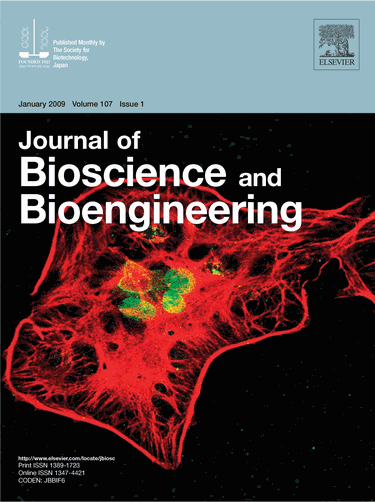
Podocyte, a terminal differentiated cell, outgrew from glomeruli and proliferated in the culture dish at day 6 after removal of glomeruli. Podocyte was double stained with fluorescence-labeled anti-Ki-67 (green) and rhodamine-conjugated phalloidin (red), respectively. The former showed that podocyte was in an active proliferation phase of cell cycle in the nuclei, and the latter showed the specific foot processing cytoskeleton formed in the differentiated cell.
This image by Prof. Pi Chao Wang at the University of Tsukuba was selected as the winner in the JBB Cover Contest. The JBB editorial board and journal staff would like to thank all participants of the contest for their contributions.
⇒JBBアーカイブ:Vol.107 (2009) ~最新号
⇒JBBアーカイブ:Vol. 93(2002)~Vol. 106(2008)
Journal of Bioscience and Bioengineering
Published by 学会事務局 on 28 1月 2011
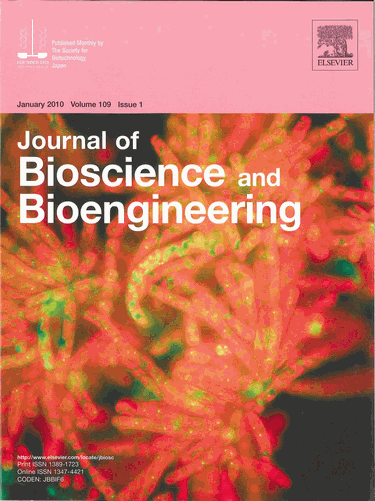
Oil-containing lipid bodies (green) are visible within live Ophiocytium maius Naegeli algal cells after vital staining with the fluorescent dye, BODIPY 505/515. Chloroplasts in these filamentous algal cells fluoresce red under the same blue light excitation.
Biotechnological applications of using BODIPY 505/515 to visualize and detect intracellular oil stores in live algal cells are discussed in Cooper, M.S. et al., “Visualizing green oil in live algal cells”, J. Biosci. Bioeng., vol. 109, 198-201 (2010).
⇒JBBアーカイブ:Vol.107 (2009) ~最新号
⇒JBBアーカイブ:Vol. 93(2002)~Vol. 106(2008)
Journal of Bioscience and Bioengineering
Published by 学会事務局 on 28 1月 2011
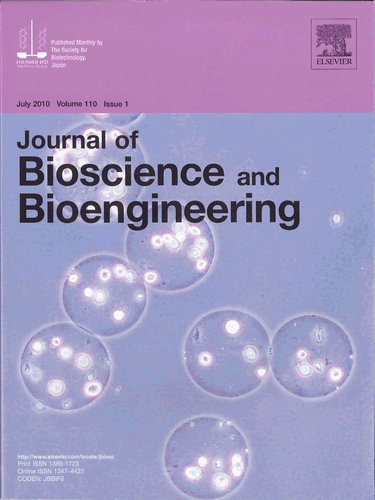
Photomicrograph of CRFK cell-enclosing microcapsules prepared from a photopolymerizable polysaccharide which was chemically-derivatized from a natural polysaccharide via irradiation with a visible light source. Diameters of the cell-enclosing microcapsules can be controlled and a low-cost LED device was used as the visible light source.
Related article: Mu, C.J. et al., “Preparation of cell-enclosing microcapsules through photopolymerization of methacrylated alginate solution triggered by irradiation with visible light”, J. Biosci. Bioeng., vol. 110, 618–620 (2010).
⇒JBBアーカイブ:Vol.107 (2009) ~最新号
⇒JBBアーカイブ:Vol. 93(2002)~Vol. 106(2008)
Journal of Bioscience and Bioengineering
Published by 学会事務局 on 28 1月 2011

Motile bacteria sense changes in the concentration of chemicals in environments and behaviorally respond to them. This behavioral response is called chemotaxis (background photos show positive chemotaxis to agarose plugs containing an attractant).
The molecular mechanisms underlie bacterial chemotaxis have been studied extensively with Escherichia coli (the left panel). It is thought that the chemotaxis machinery of other motile bacteria is basically similar to that of E. coli.
E. coli possesses only five chemotaxis sensory proteins. However, sequence analysis of bacterial genomes revealed that quite a few environmental bacteria have a number of (20-50) chemotaxis sensory proteins, suggesting that these environmental bacteria can respond to much more chemical compounds than E. coli does. For example, Pseudomonas aeruginosa is attracted to inorganic phosphate (Pi), but not E. coli. Pi taxis in P. aeruginosa is induced under conditions of Pi limitation. P. aeruginosa PAO1 possesses two chemotaxis sensory proteins for Pi, CtpH and CtpL, which are functional at different concentrations of phosphate (the right panel).
CtpL serves as the major chemoreceptor for phosphate at low concentrations, while CtpH is required for exhibiting phosphate taxis at high concentrations of phosphate. The induction mechanism of phosphate taxis in P. aerguginosa is complicated. In P. aeruginosa, phosphate limitation elicits the synthesis of several proteins such as alkaline phosphatase, phosphate-specific transport (Pst) complex, a hemolytic phospholipase C and a nonhemolytic phospholipase C. These gene promoters are positively regulated by a PhoB/PhoR two component regulatory system, whereas the Pst complex, together with PhoU, negatively regulates the phosphate regulon in P. aeruginosa. CtpH expression is not dependent on the PhoB/PhoR proteins.
The Pst complex and PhoU are likely to exert a negative control on CtpH expression at posttranscriptional level. The ctpL gene is a member of the phosphate regulon and PhoB/PhoR are essential for its transcription. A putative PhoB-binding sequence (pho box) exists in the ctpL promoter region. The ctpL gene is constitutively transcribed in pst and phoU mutants of P. aeruginosa, however, the mutant strains fail to show a chemotactic response toward low concentrations of phosphate, suggesting that the Pst complex and PhoU are required for the phosphate detection by CtpL.
Related article: Kato, J., Kim, H-E., Takiguchi, N., Kuroda, A., and Ohtake, H., “Pseudomonas aeruginosa as a model microorganism for investigation of chemotactic behaviors in ecosystem“, J. Biosci. Bioeng., vol. 106, 1-7 (2008).
Illustration designed by Ms. Azusa Fujita.
⇒JBBアーカイブ:Vol.107 (2009) ~最新号
⇒JBBアーカイブ:Vol. 93(2002)~Vol. 106(2008)
Journal of Bioscience and Bioengineering
Published by 学会事務局 on 28 1月 2011
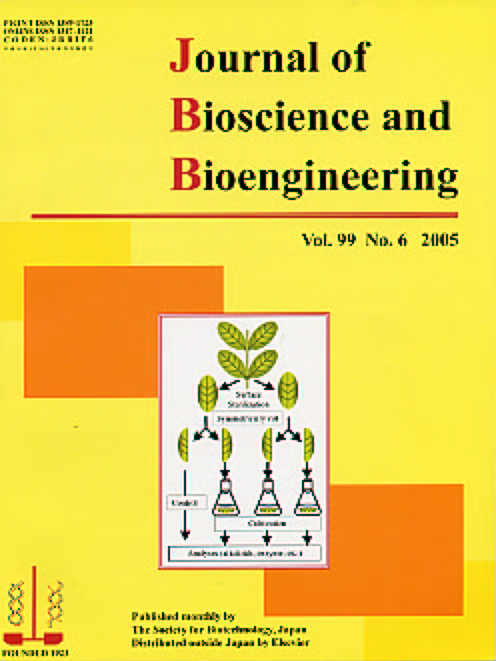
A novel production method for useful chemicals involving direct culture of plant leaves.
Current production systems for plant secondary metabolites involving dedifferentiated cells (callus) have some disadvantages for industrial scale application. The instability of metabolite productivity by cells is one of the most important factors. As illustrated on the cover, a novel method for the production of secondary metabolites involving direct culture of intact plant leaves, but not dedifferentiated cells (callus), was developed. Terpenoid indole alkaloids such as ajmalicine and serpentine were shown to be efficiently produced when intact leaves of Catharanthus roseus were cultured in the phytohormone-free liquid medium, this being the first step in the development of a novel and promising production system for plant secondary metabolites.
Rlated article: Iwase, A., Aoyagi, H., Ohme-Takagi, M., and Tanaka, H.,“Development of a novel system for producing ajmalicine and serpentine using direct culture of leaves in Catharanthus roseus intact plant”, J. Biosci. Bioeng., vol. 99, 208-215 (2005), dx.doi.org/10.1263/jbb.99.208.
⇒JBBアーカイブ:Vol.107 (2009) ~最新号
⇒JBBアーカイブ:Vol. 93(2002)~Vol. 106(2008)
Journal of Bioscience and Bioengineering
Published by 学会事務局 on 28 1月 2011
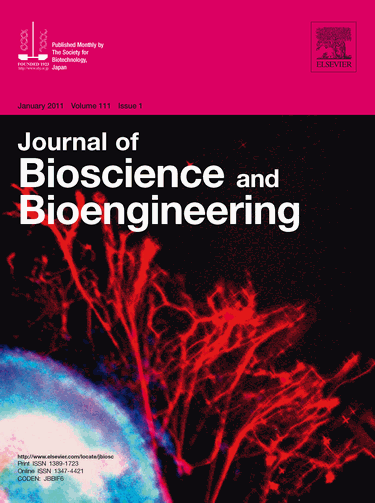
Photomicrograph of neuronal cells projected from an attached embryoid body (EB) of mouse ES cells. βIII-tubulin, a neuron-specific marker, was stained with Alexa Fluor 594. βIII-tubulin-positive cells more abundantly developed from the EBs grown in 5.5 mM glucose than from the EBs grown in 20 mM glucose.
[Related article] Hidemi Mochizuki, Yoshitsugu Ohnuki, Hiroshi Kurosawa: Effect of glucose concentration during embryoid body (EB) formation from mouse embryonic stem cells on EB growth and cell differentiation. J. Biosci. Bioeng., vol. 111, p. 92-97 (2011)
Original image was taken by Mayumi Maeda at University of Yamanashi.
⇒JBBアーカイブ:Vol.107 (2009) ~最新号
⇒JBBアーカイブ:Vol. 93(2002)~Vol. 106(2008)
Journal of Bioscience and Bioengineering
Published by 学会事務局 on 30 7月 2008







